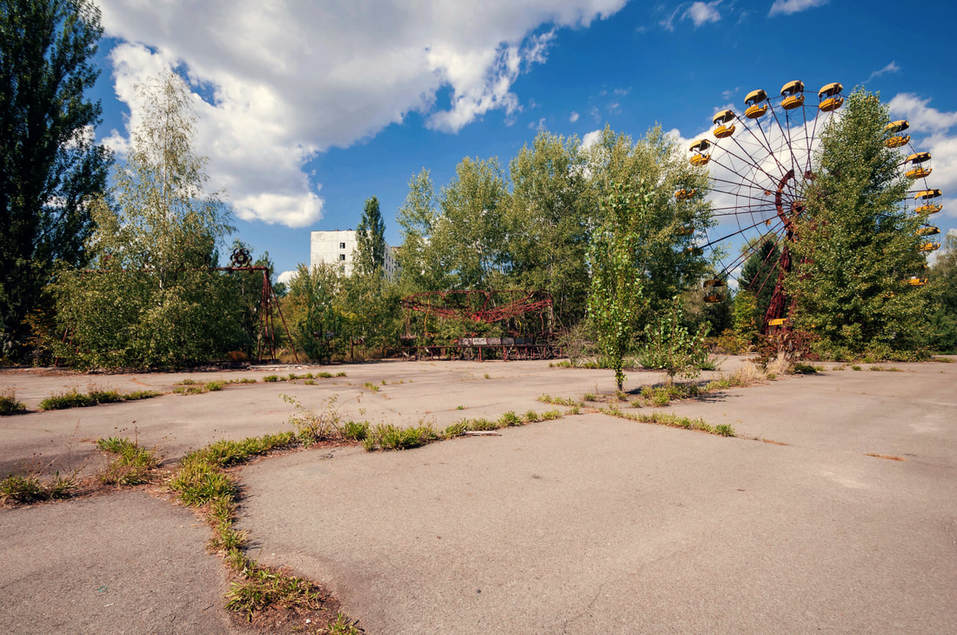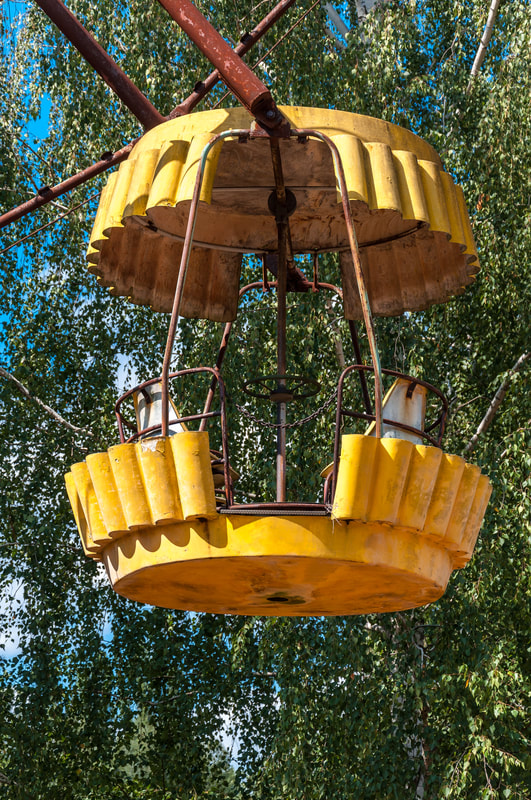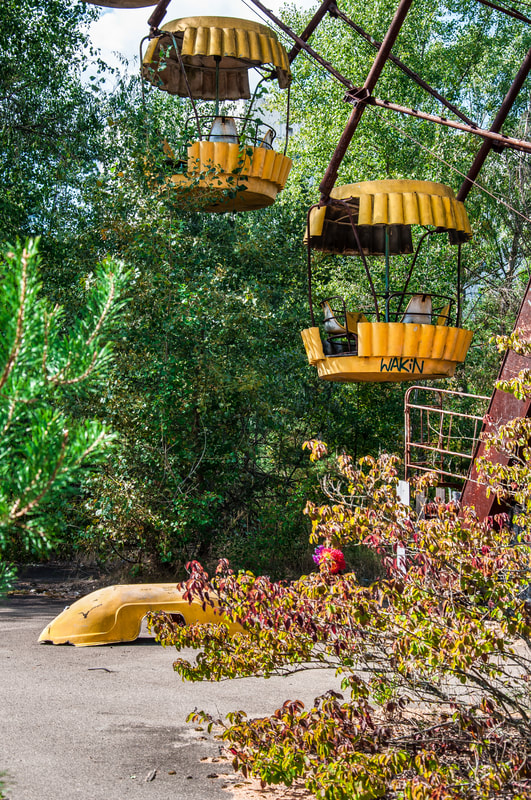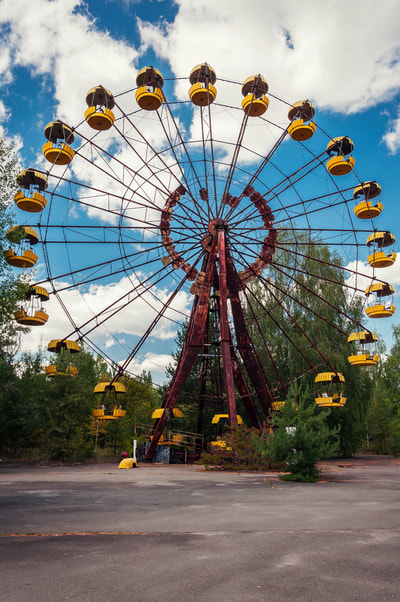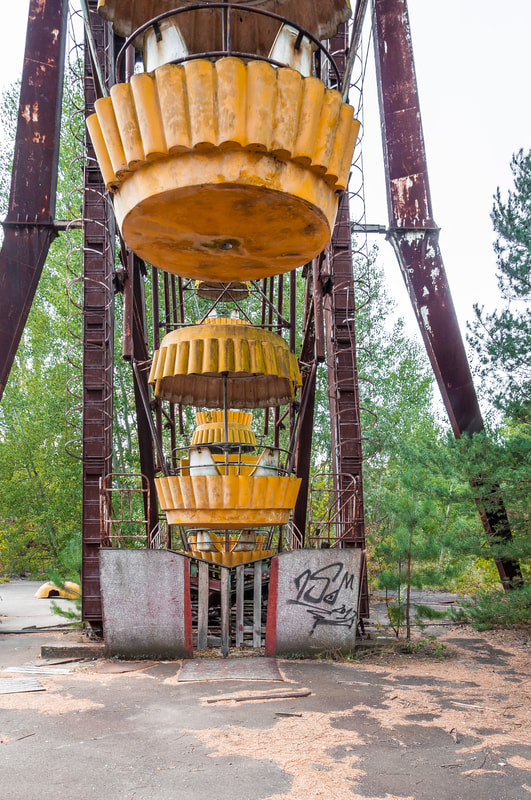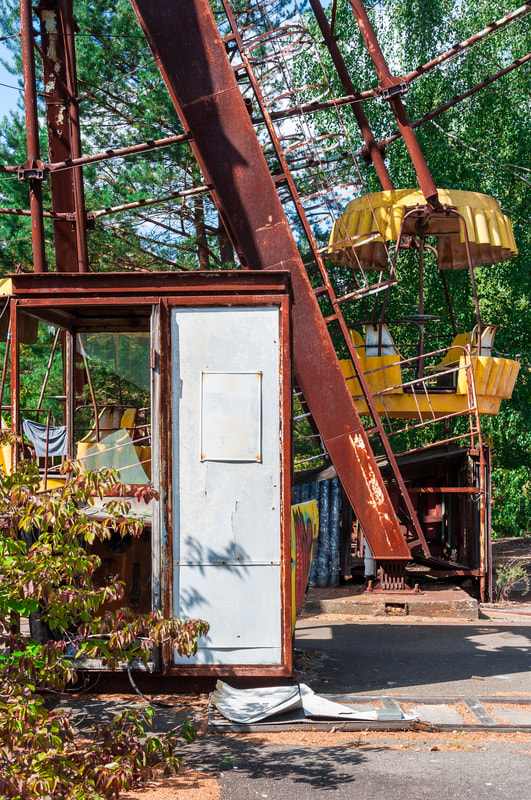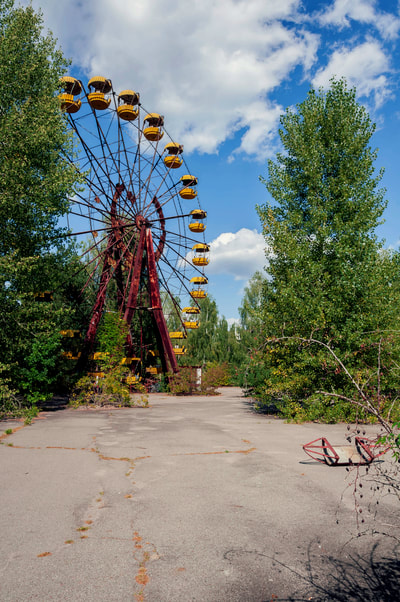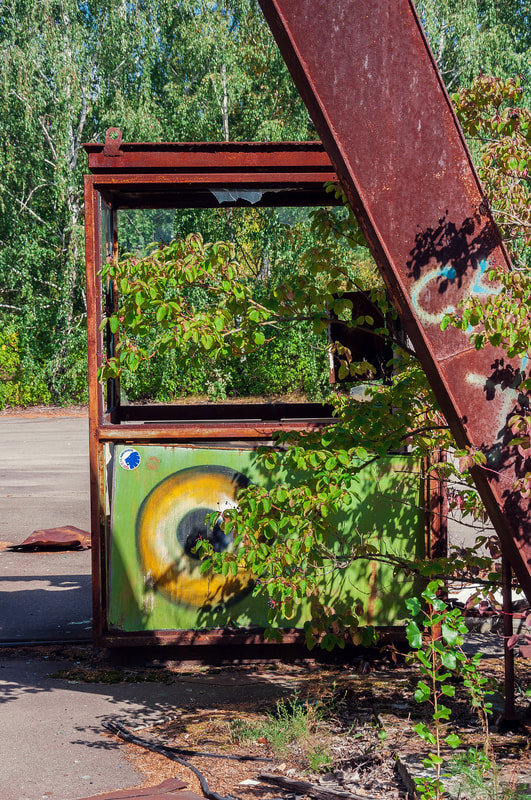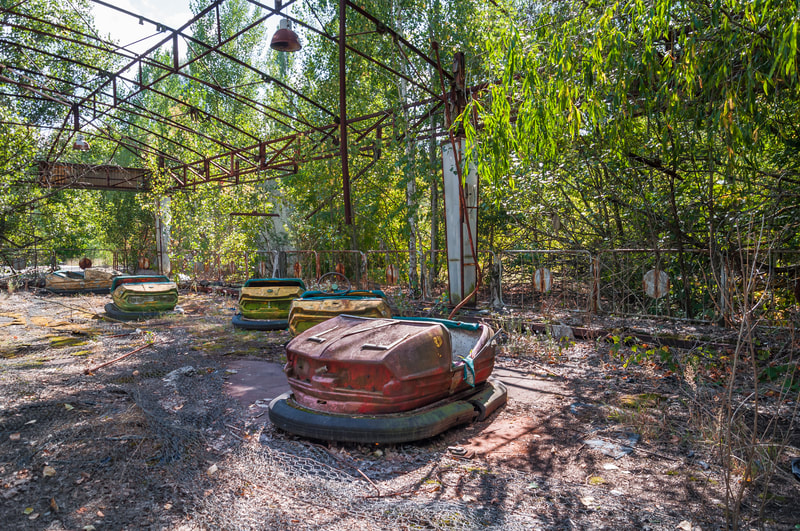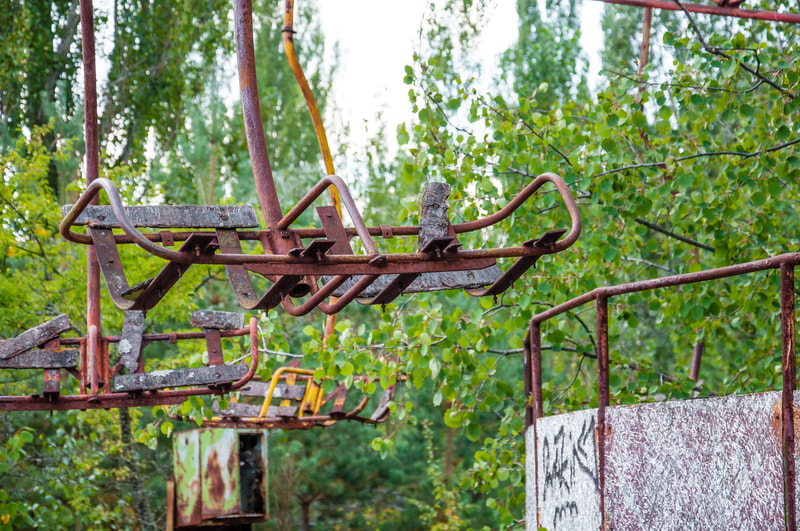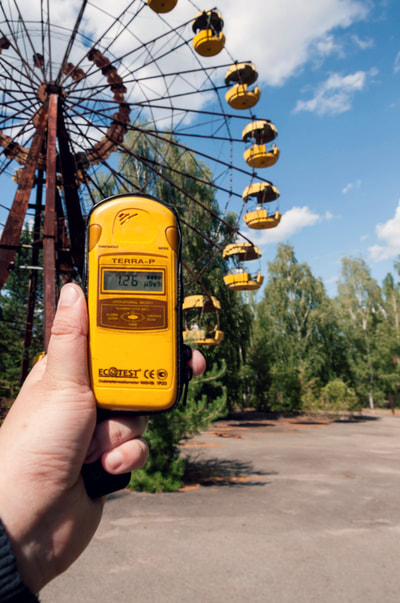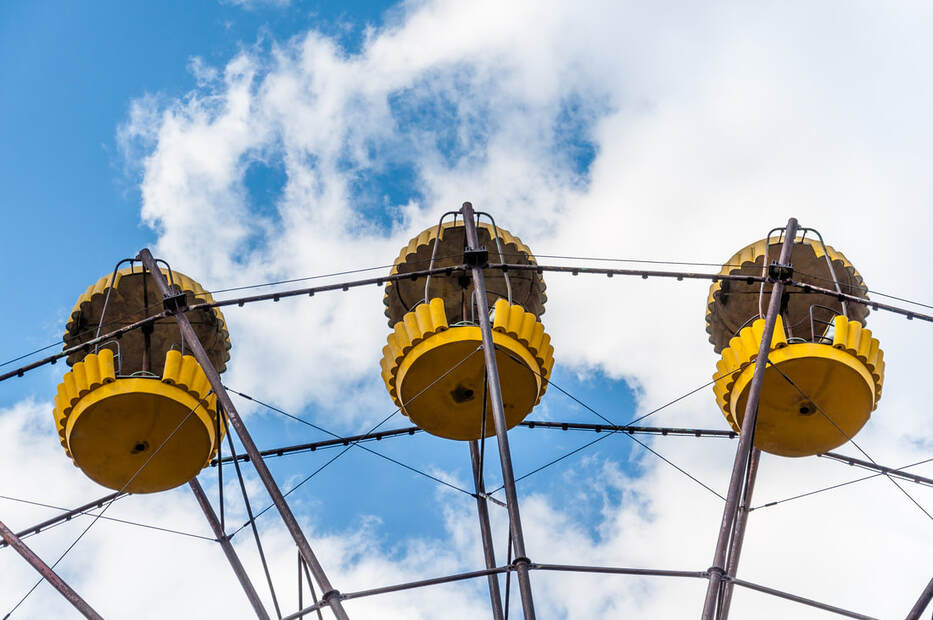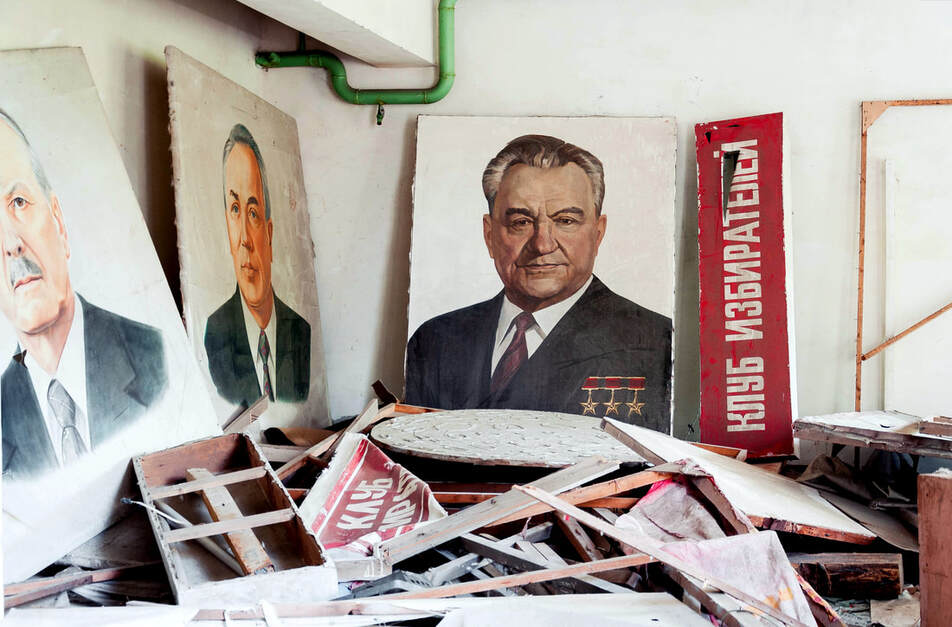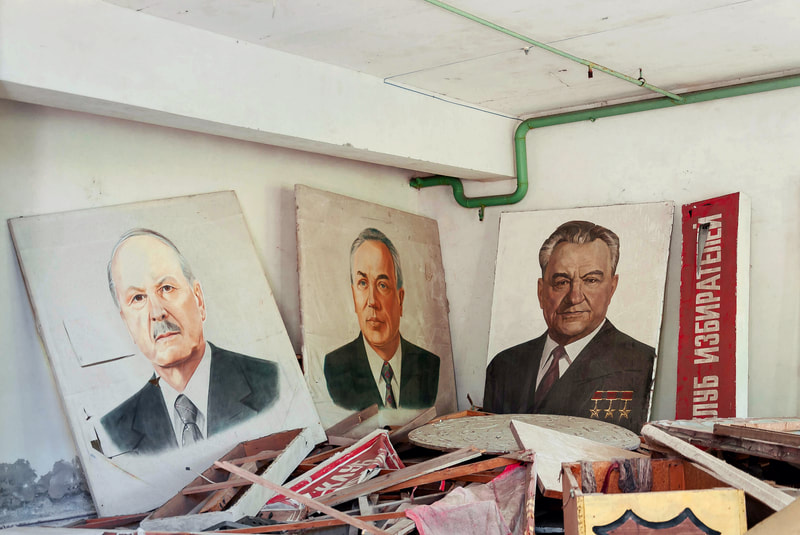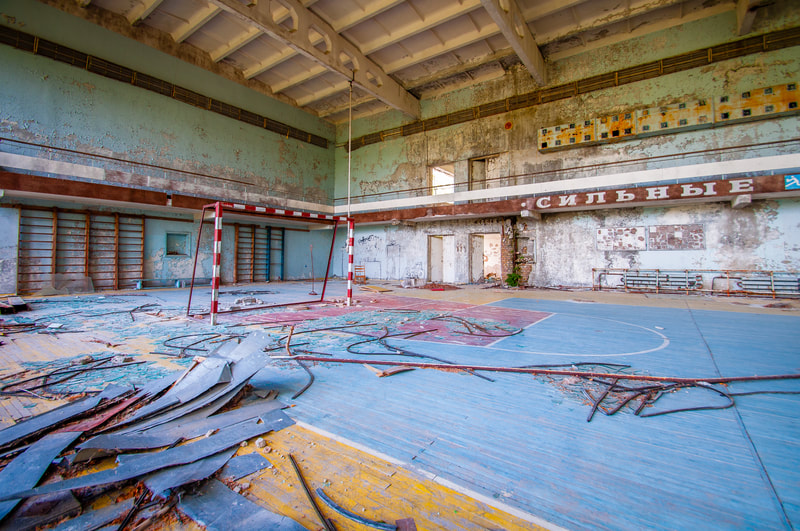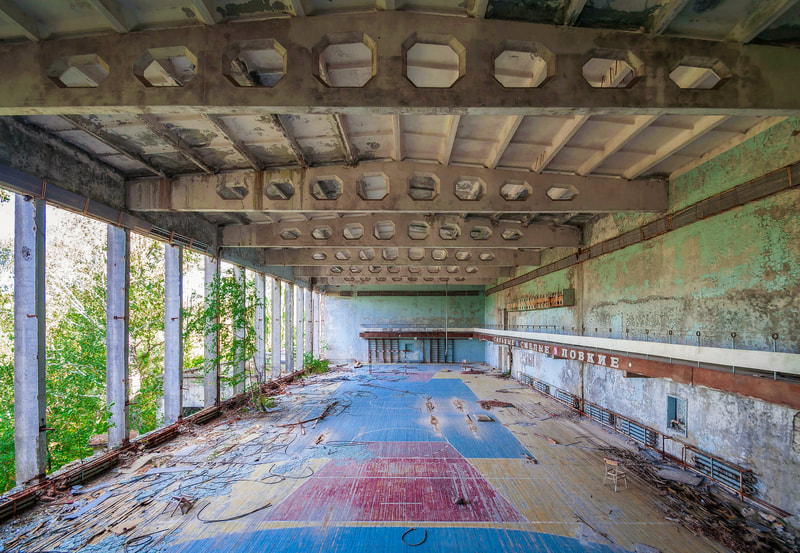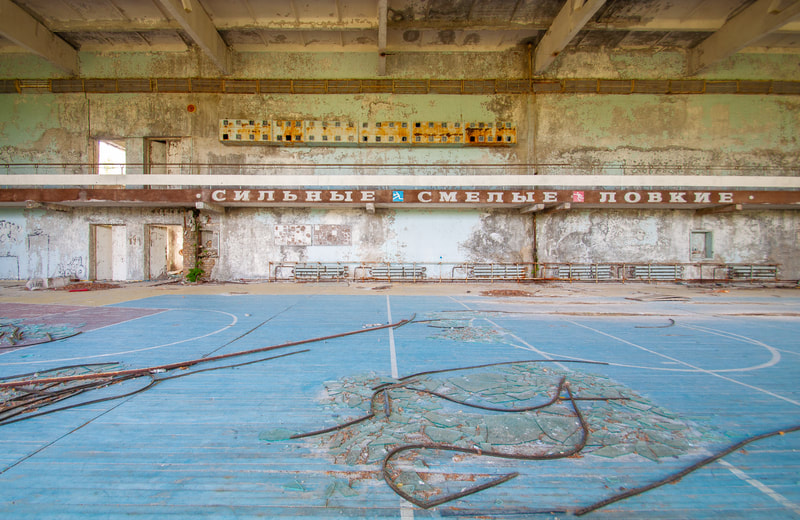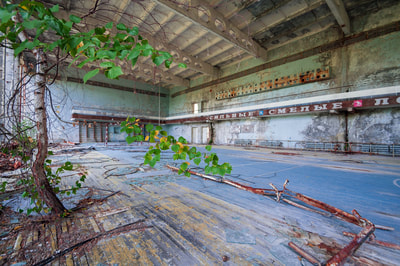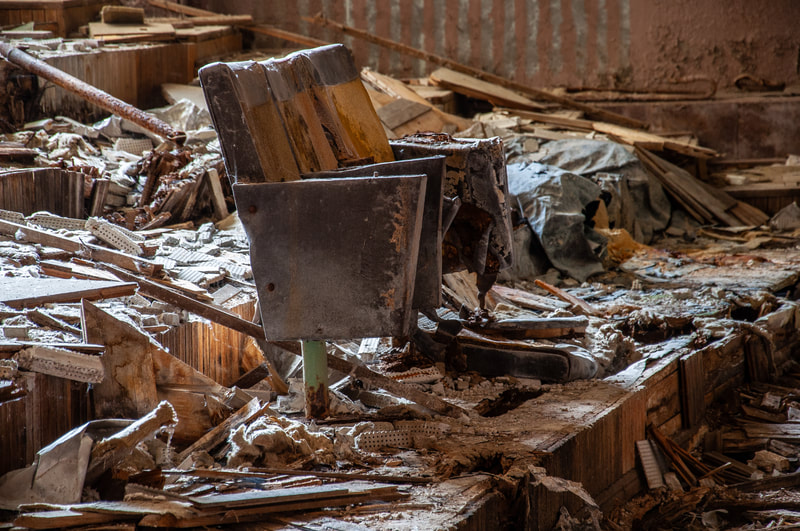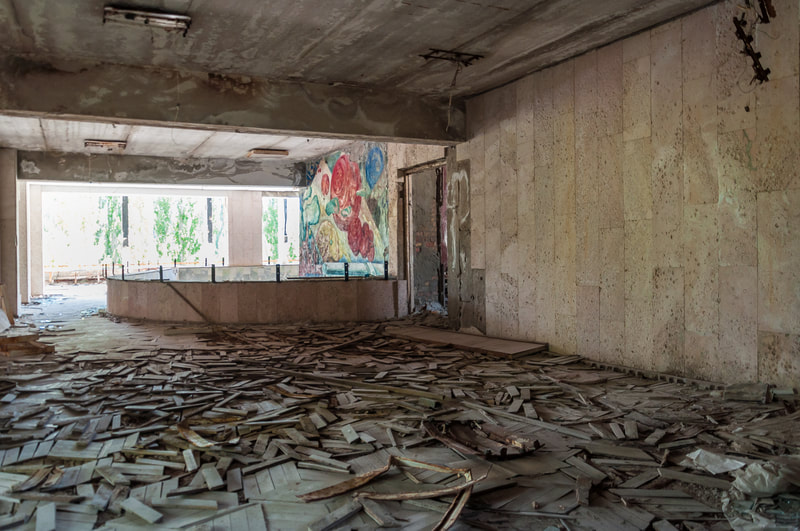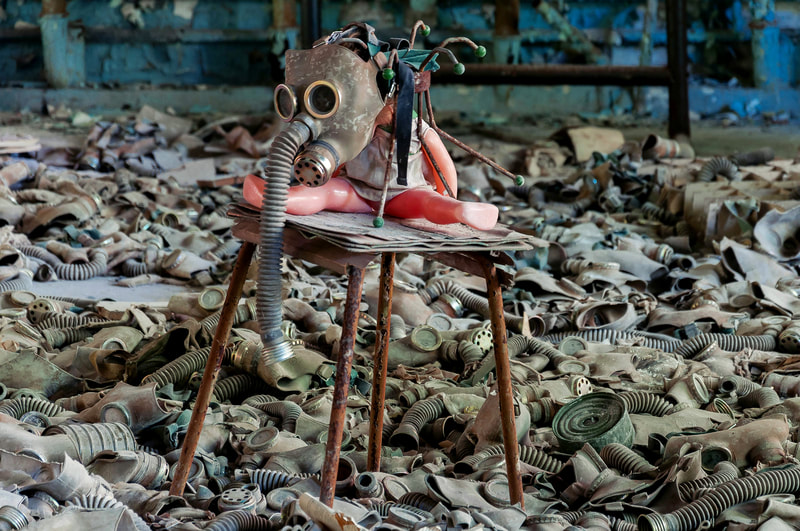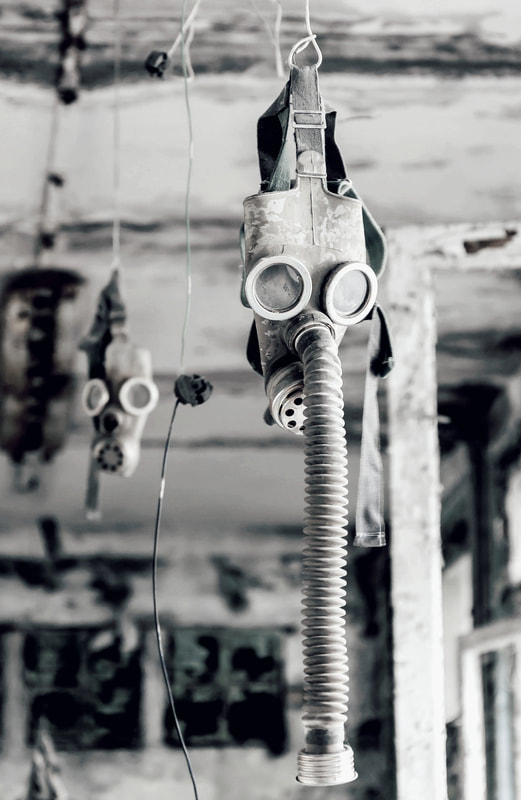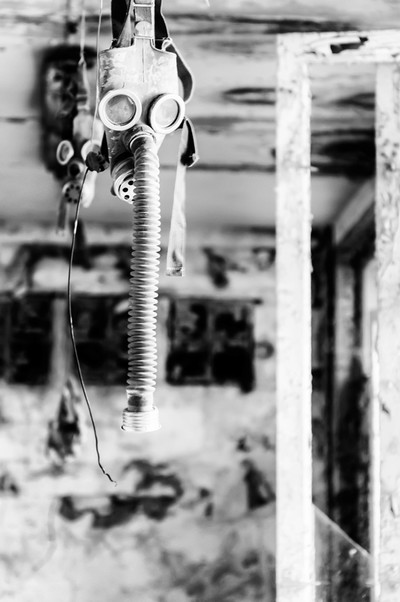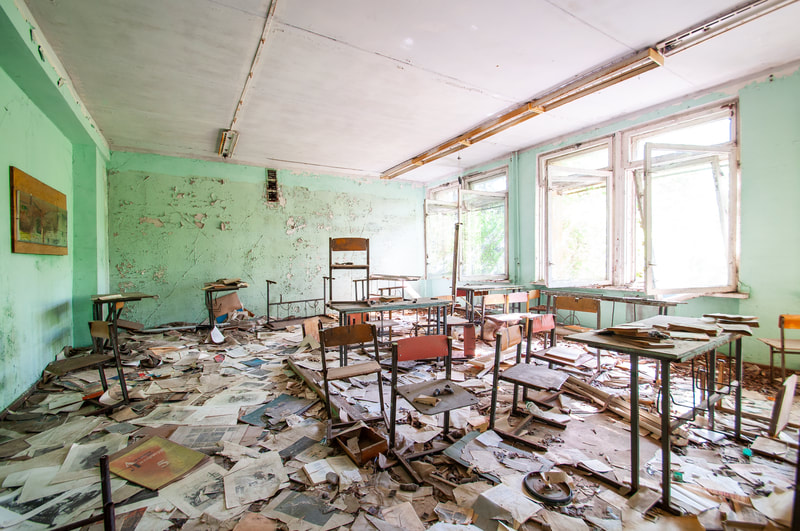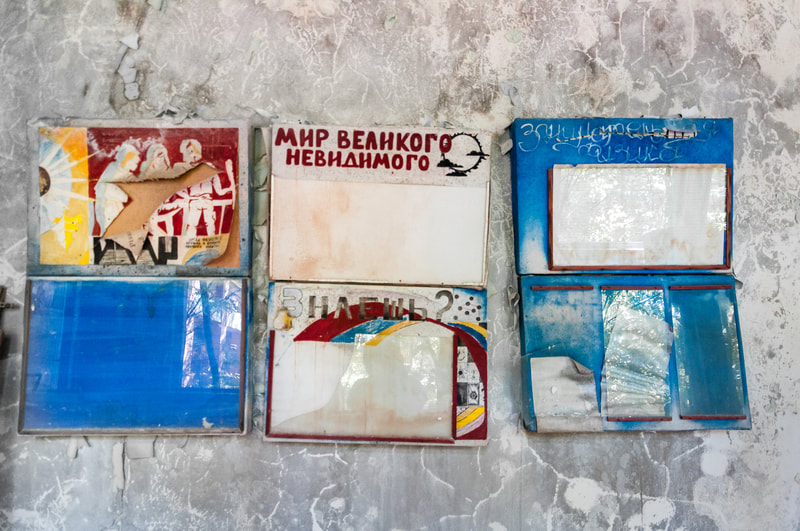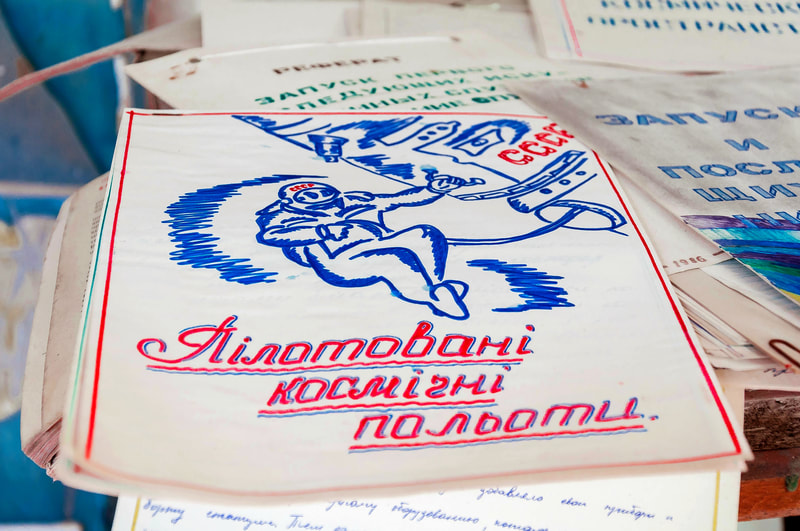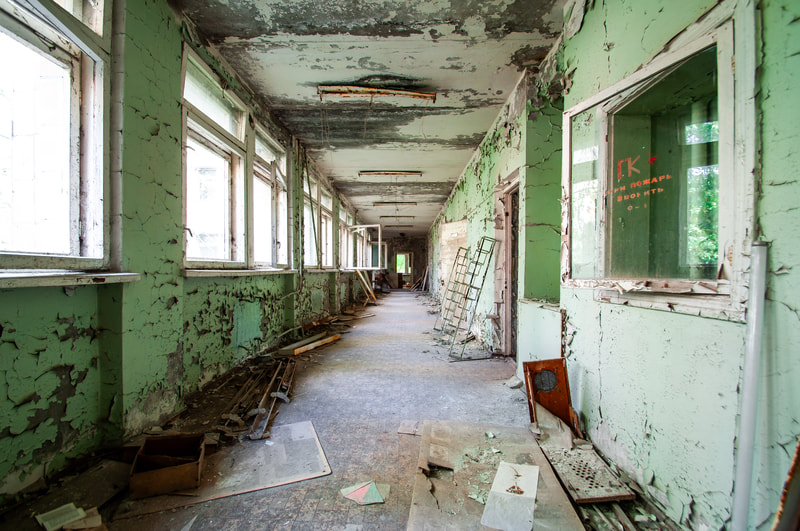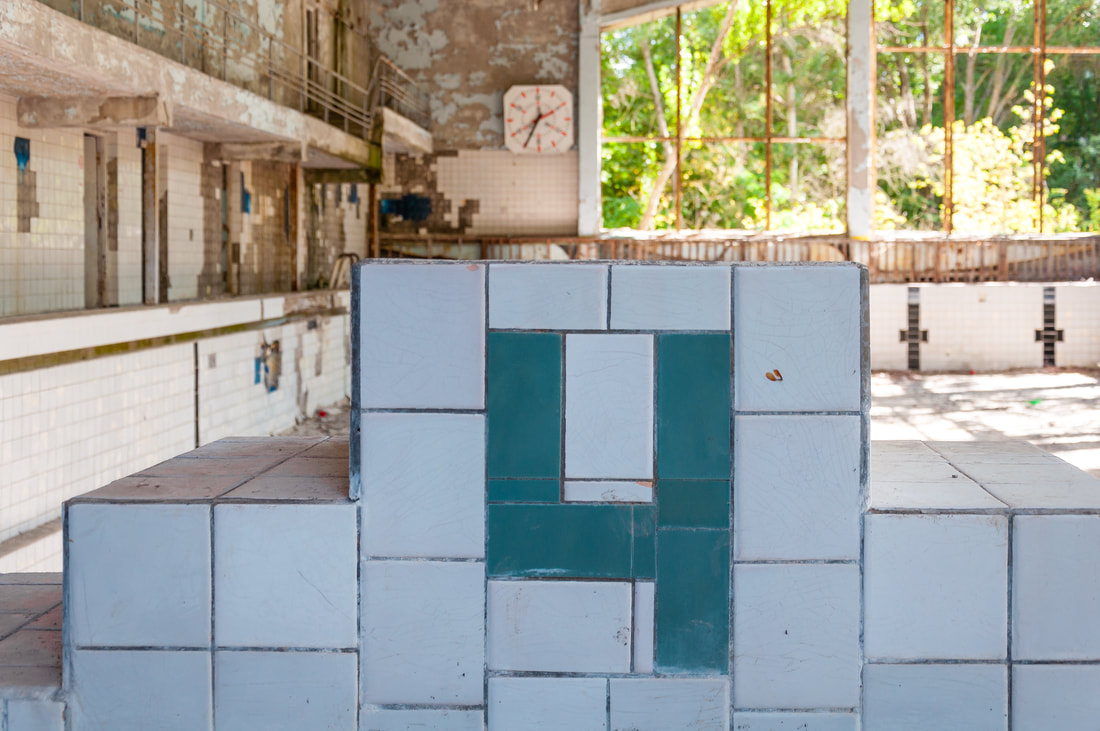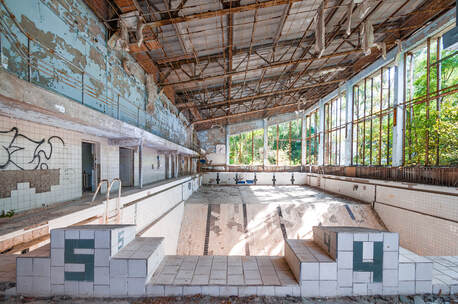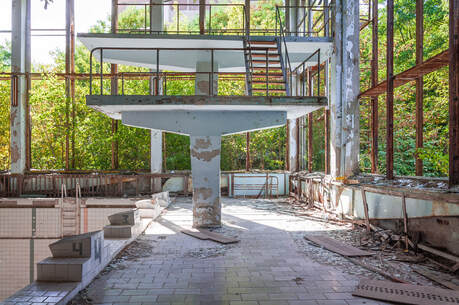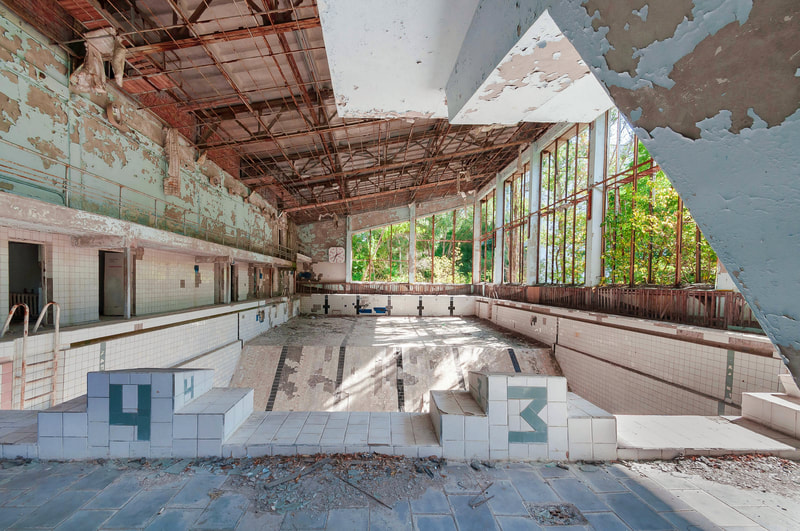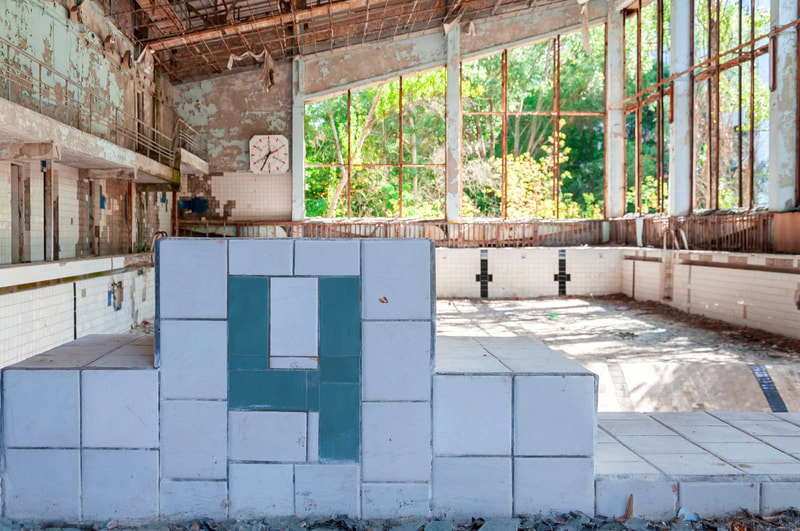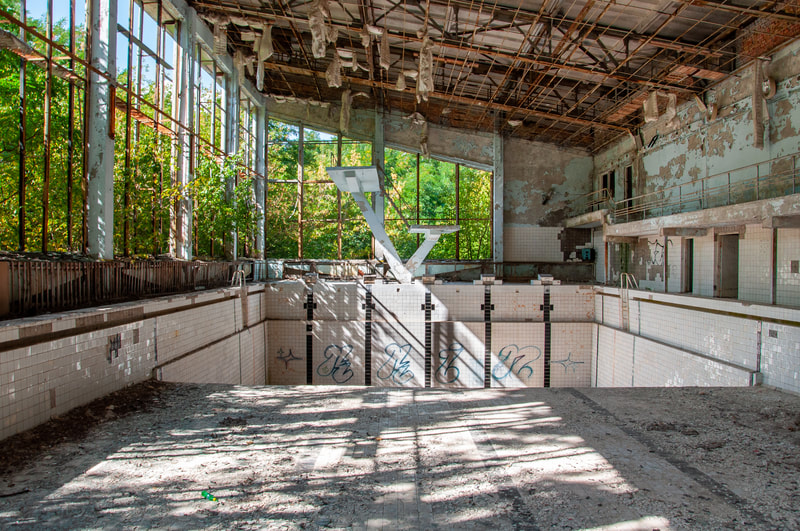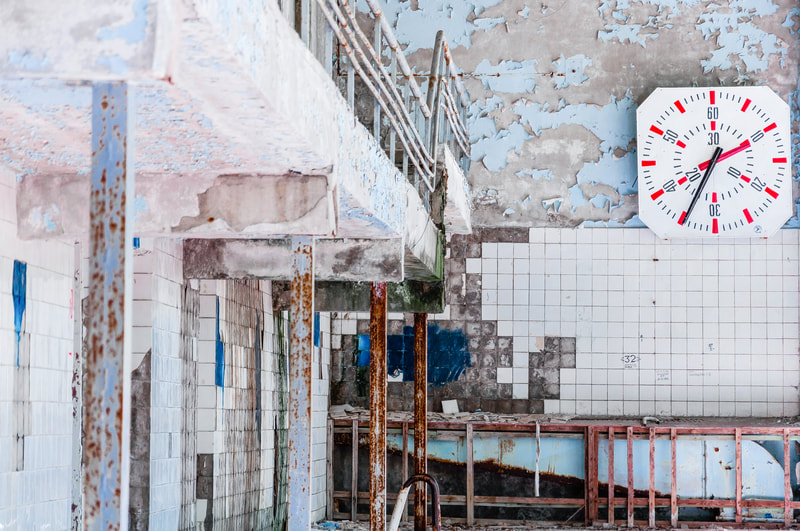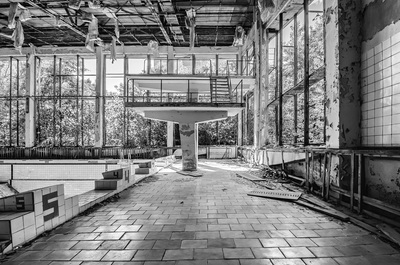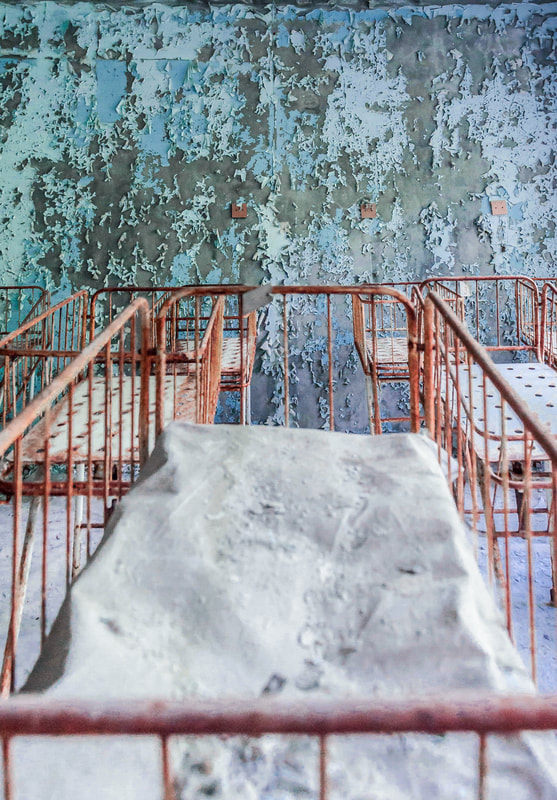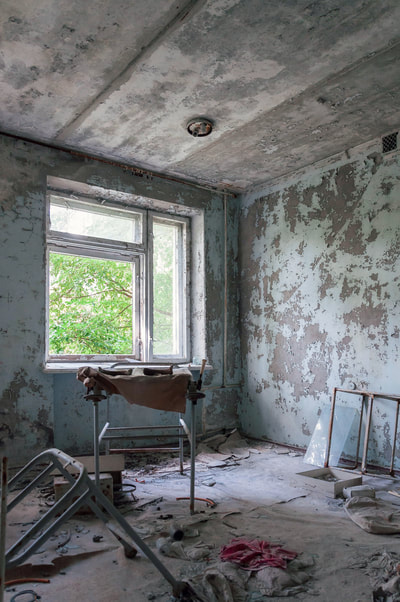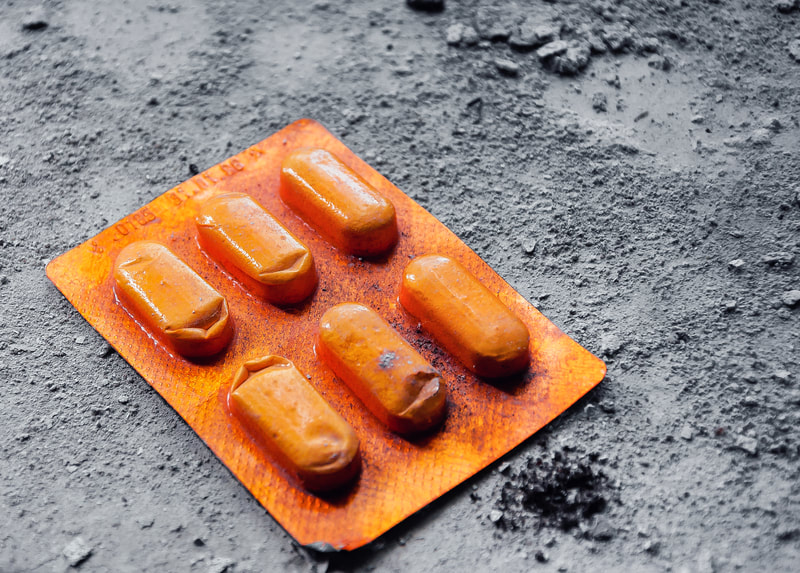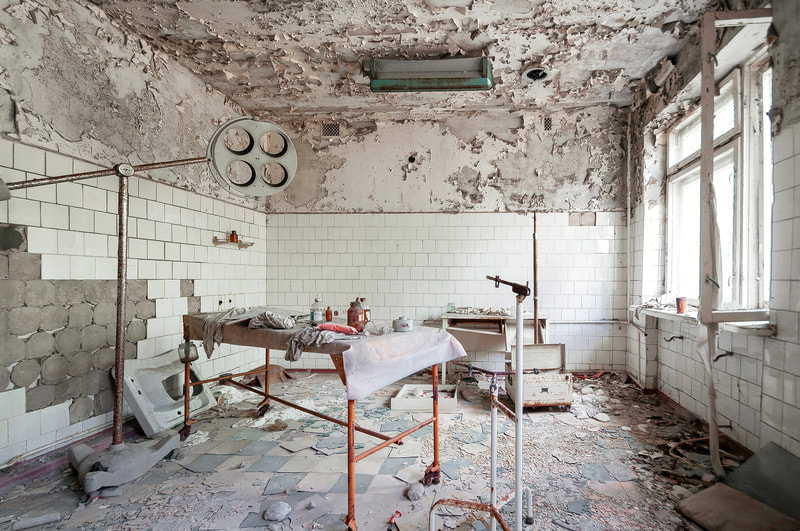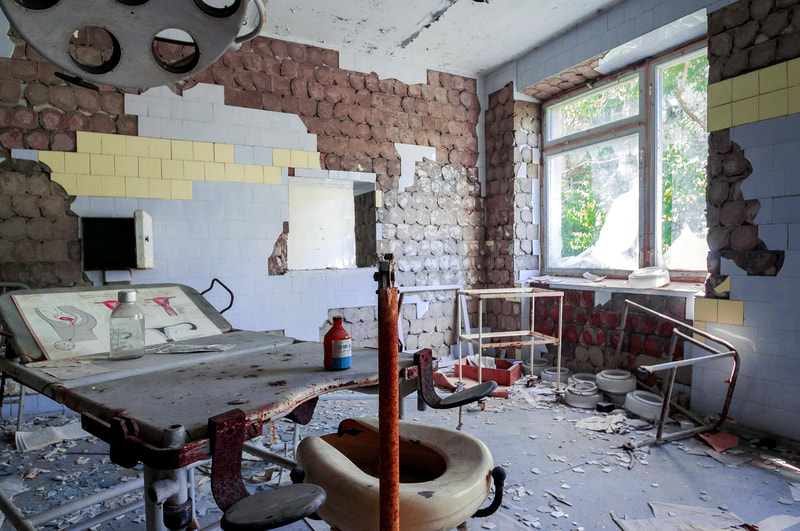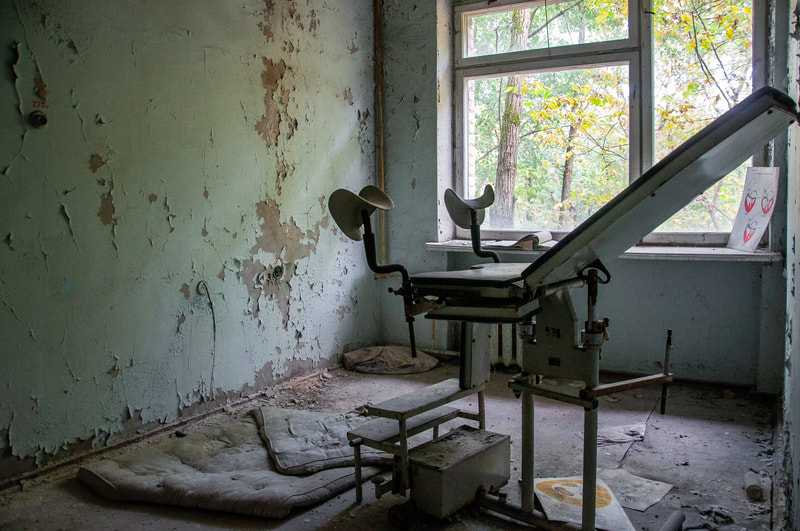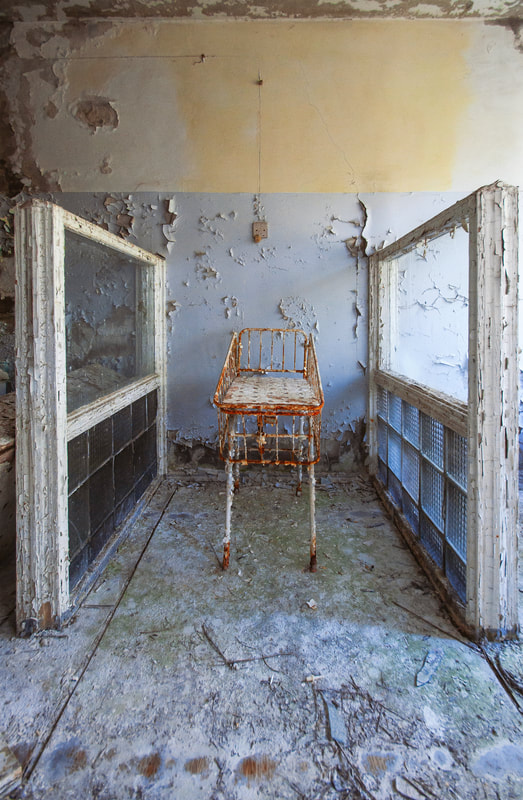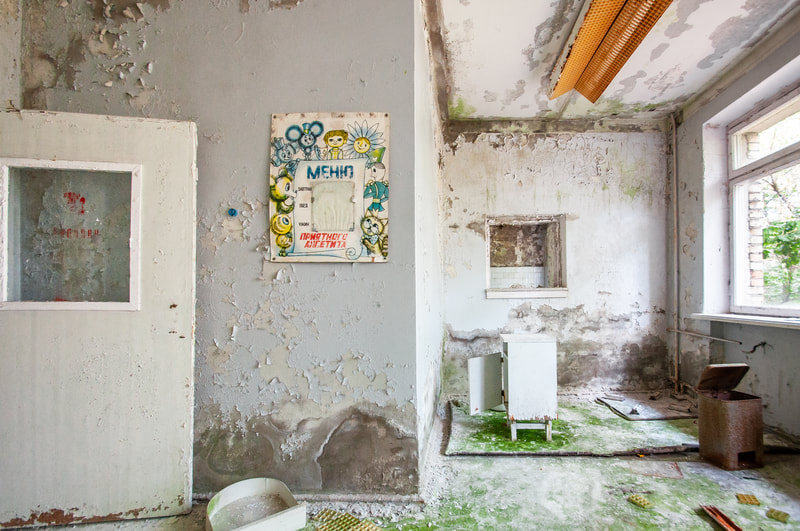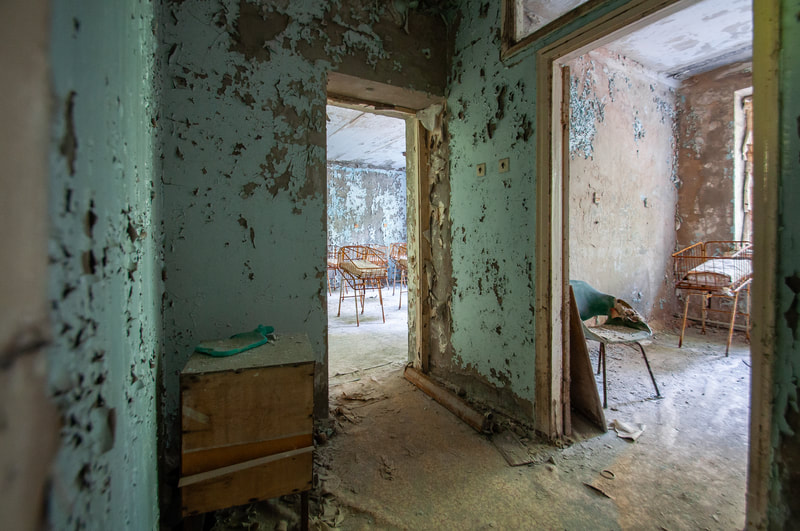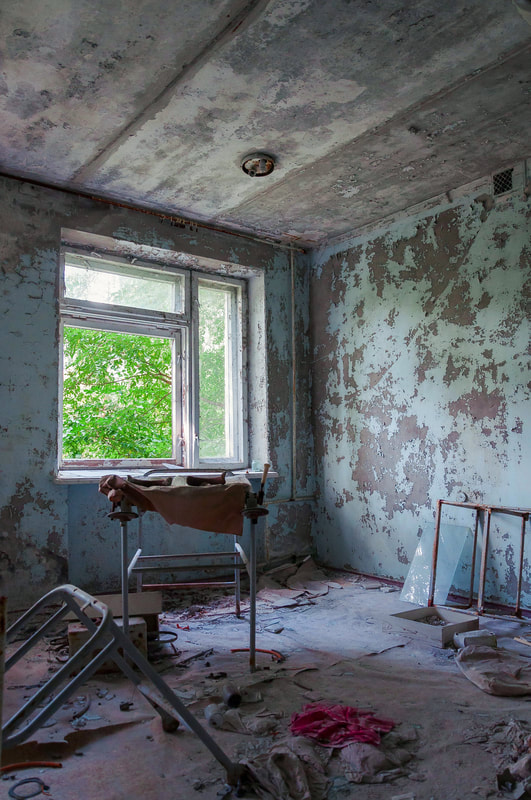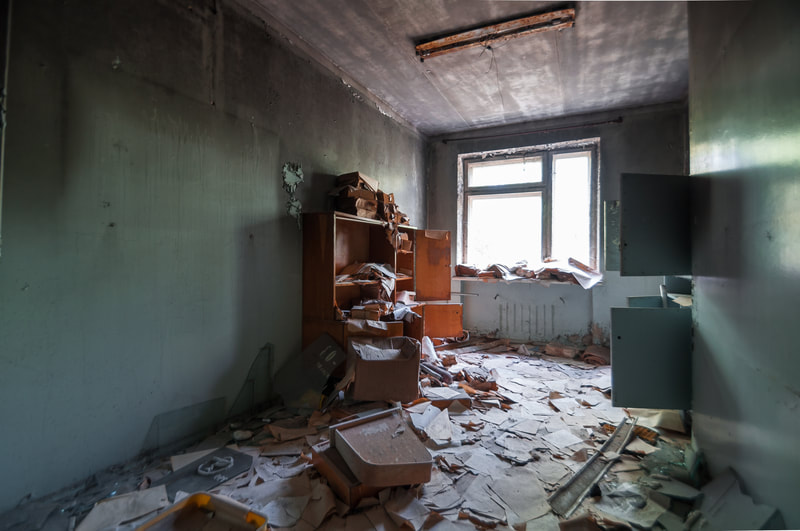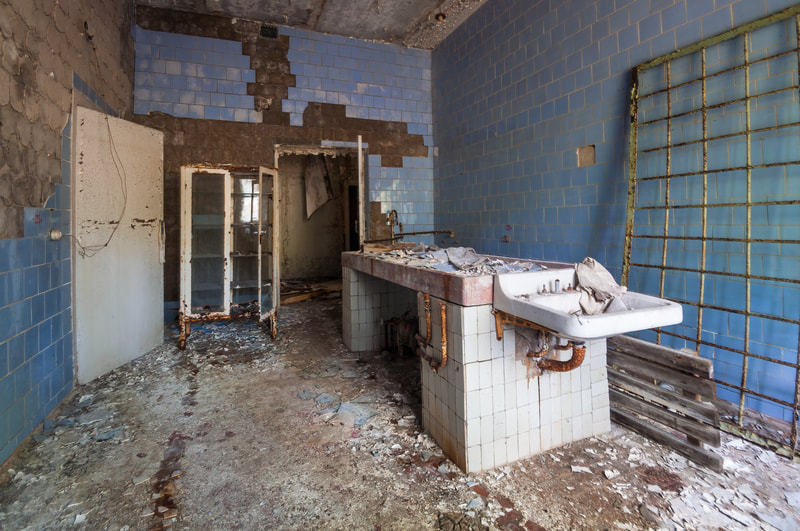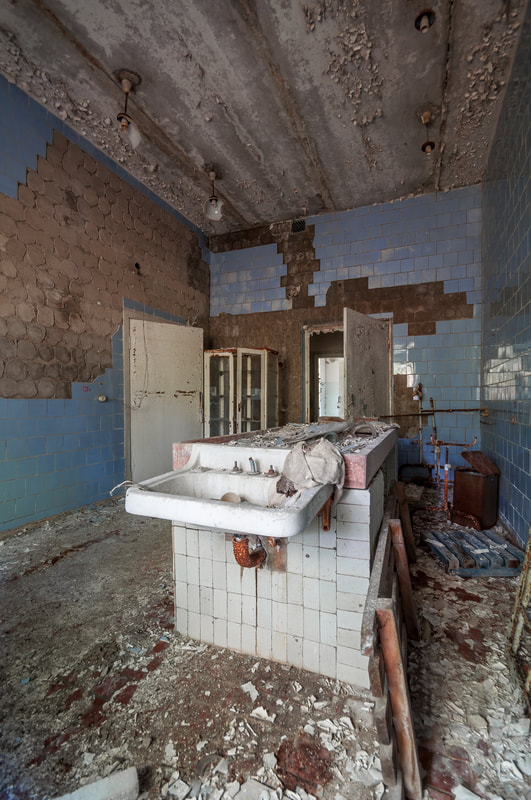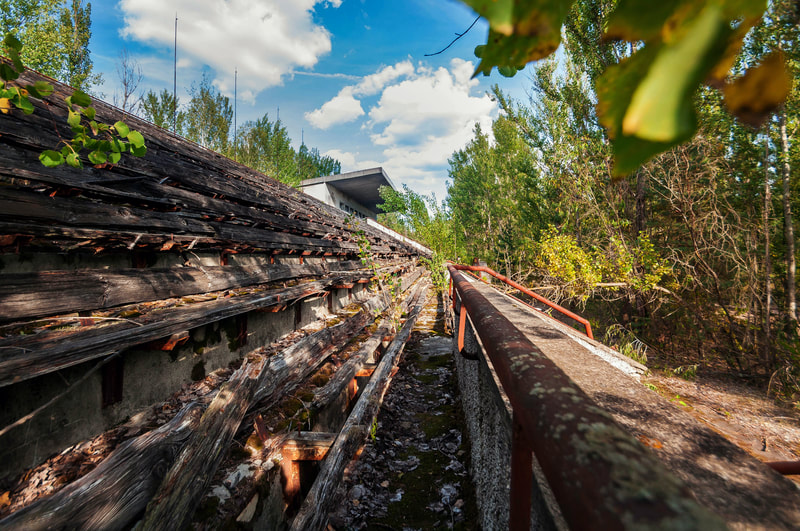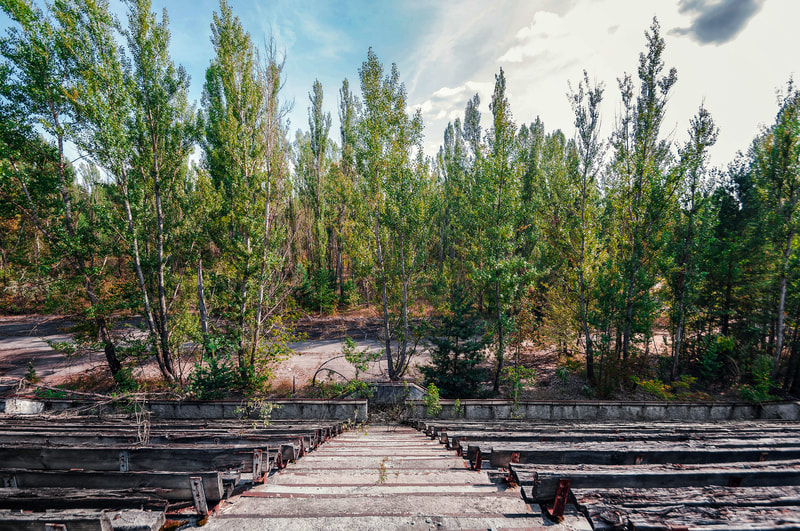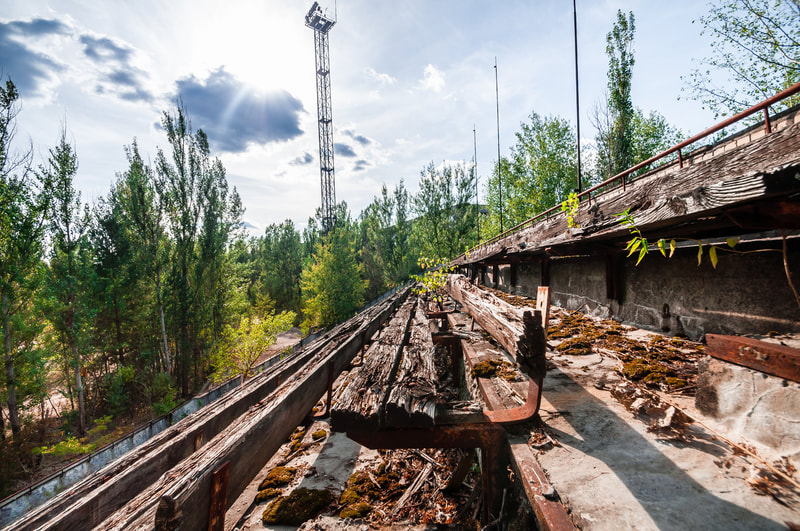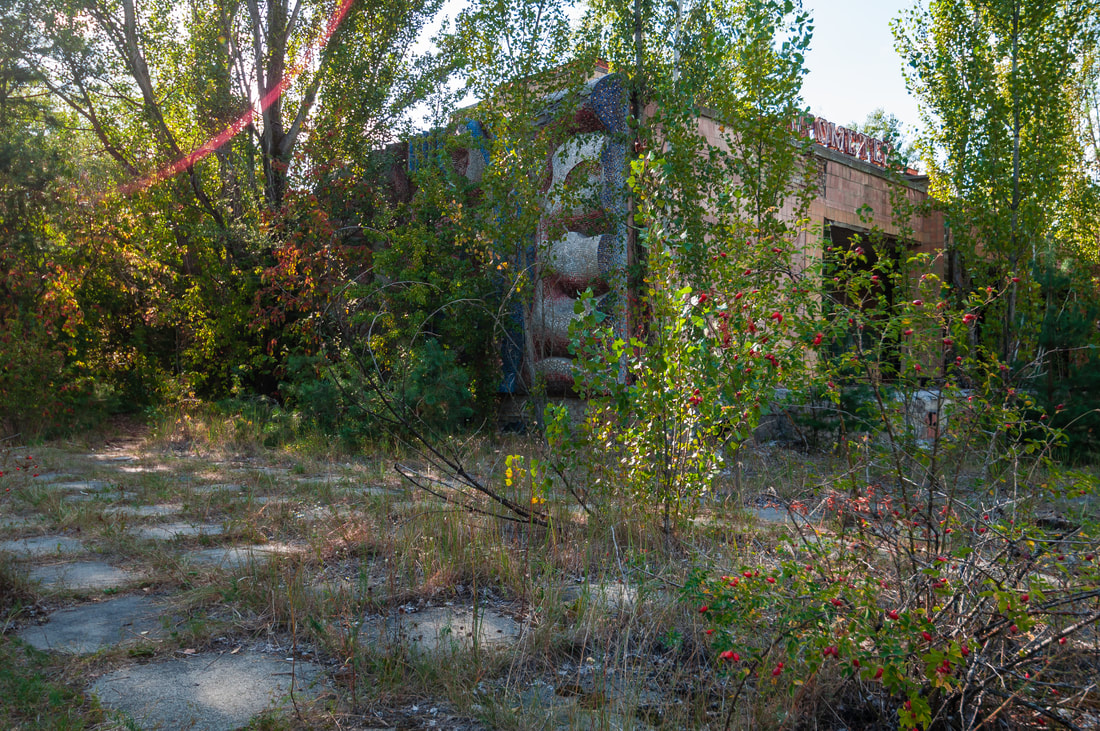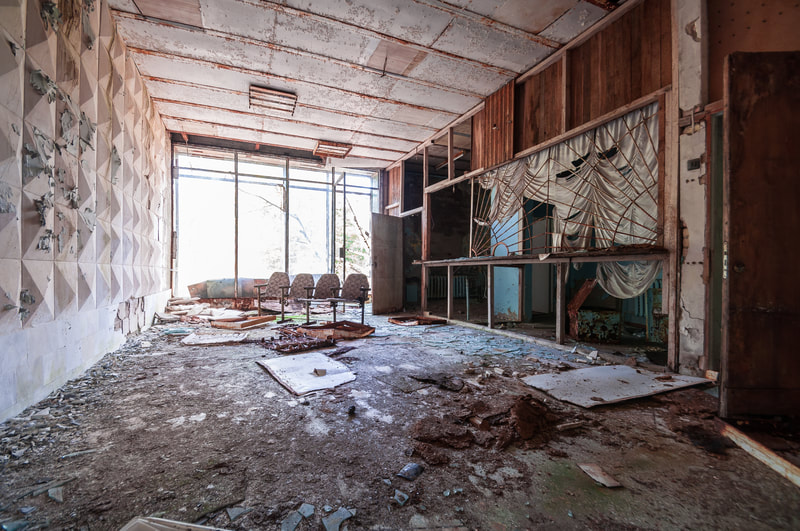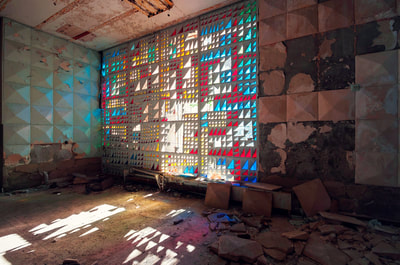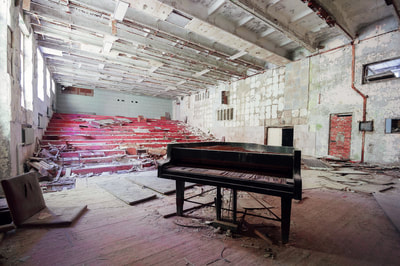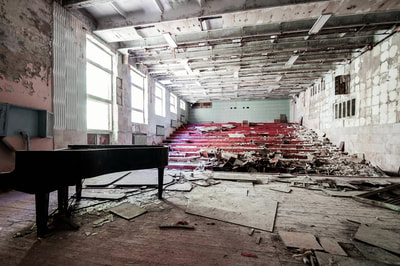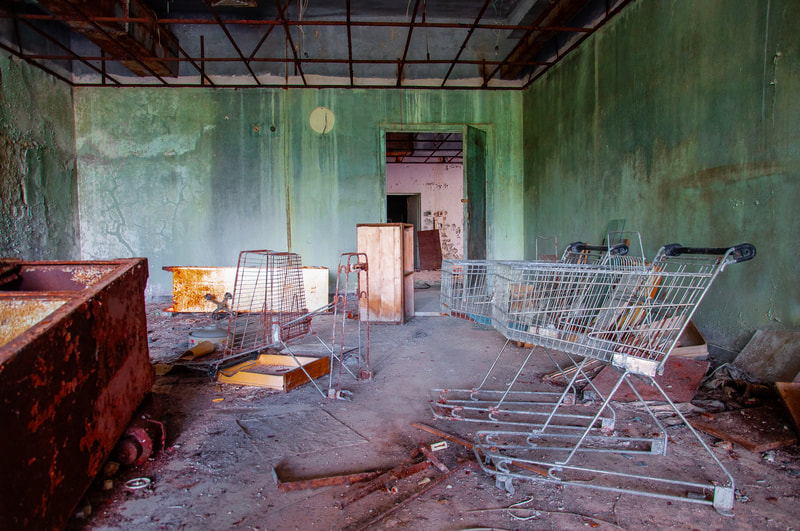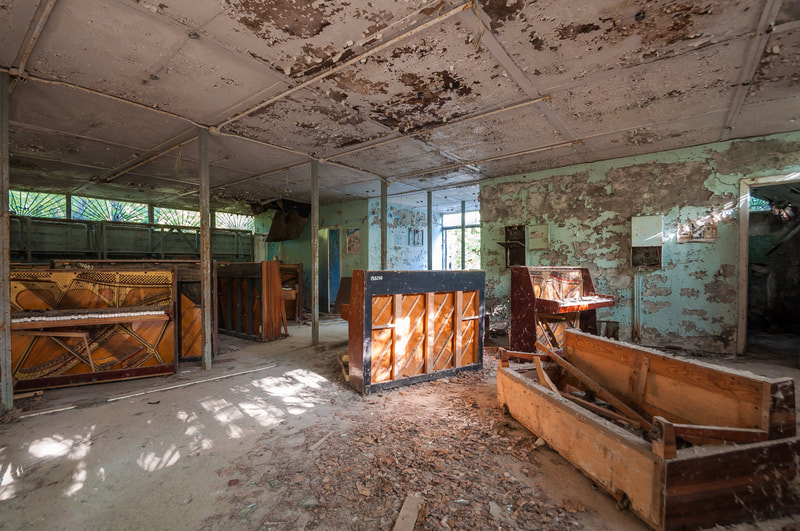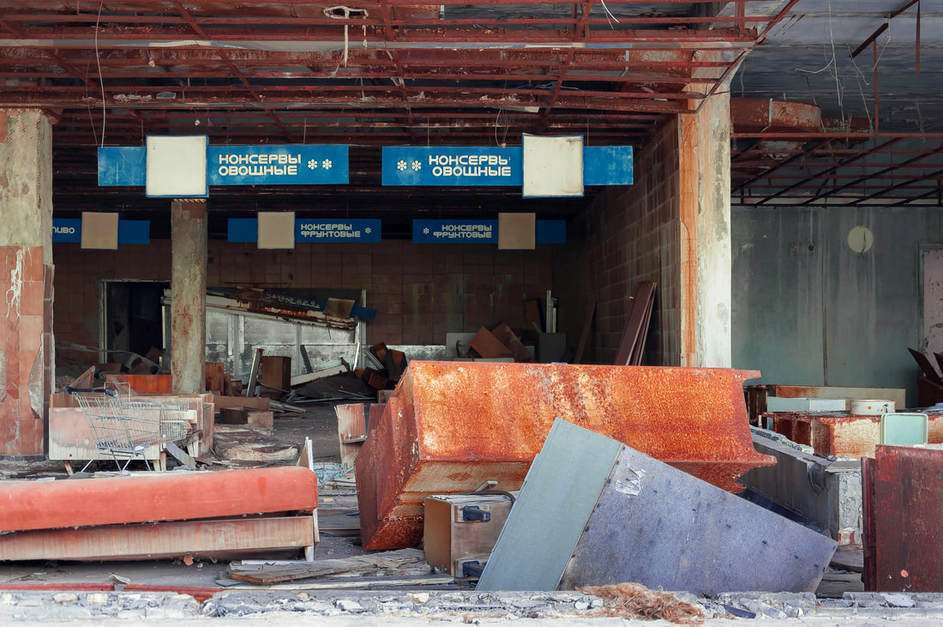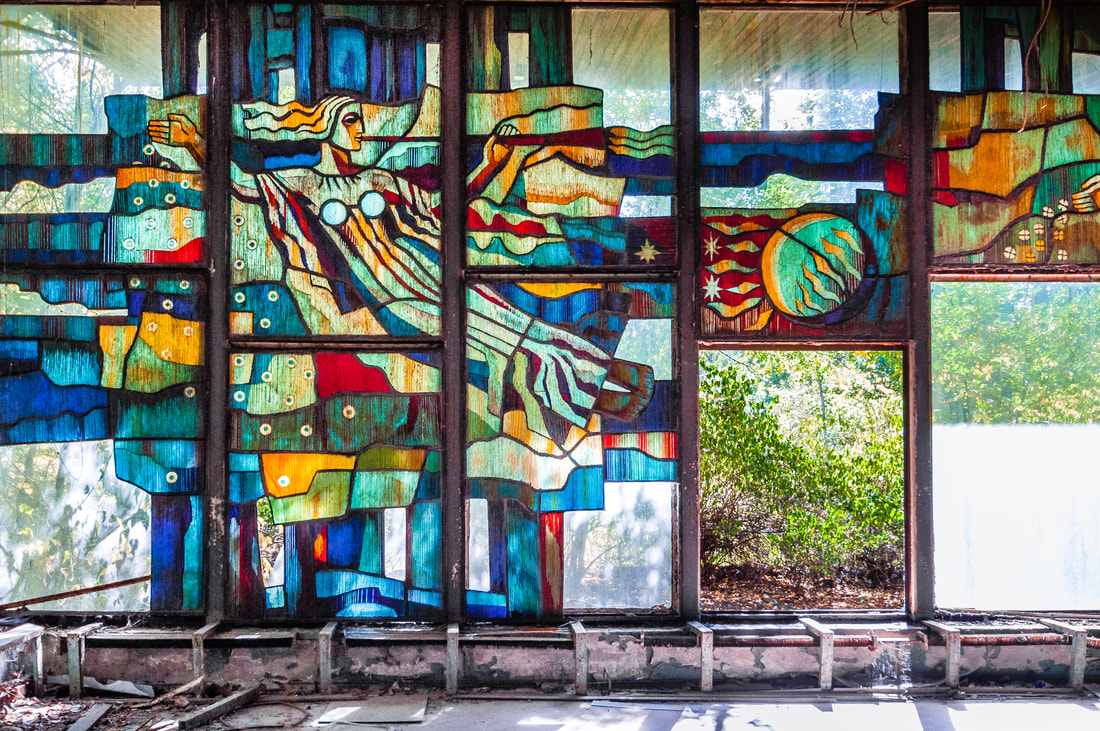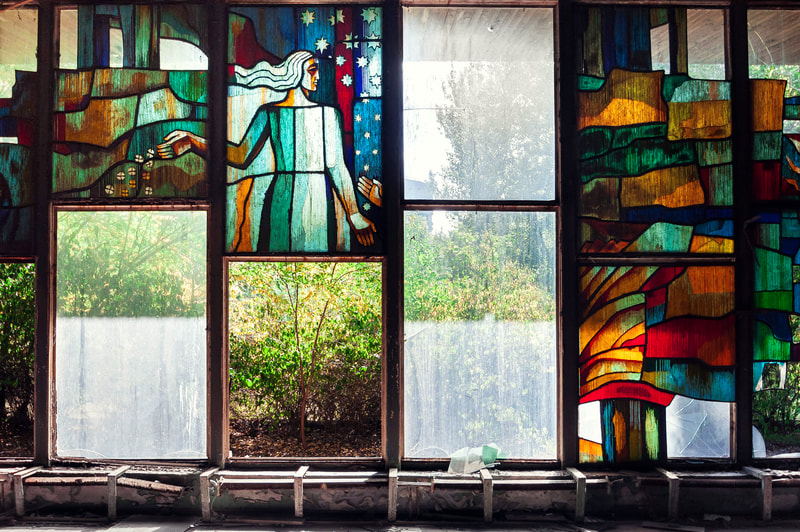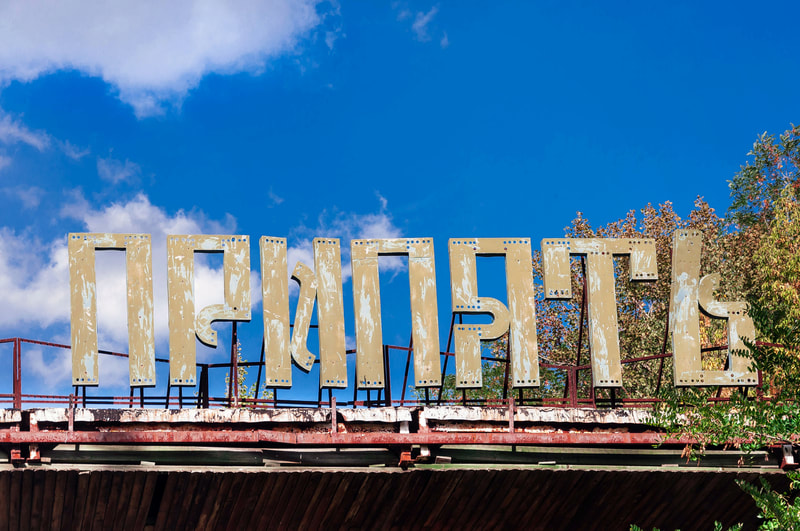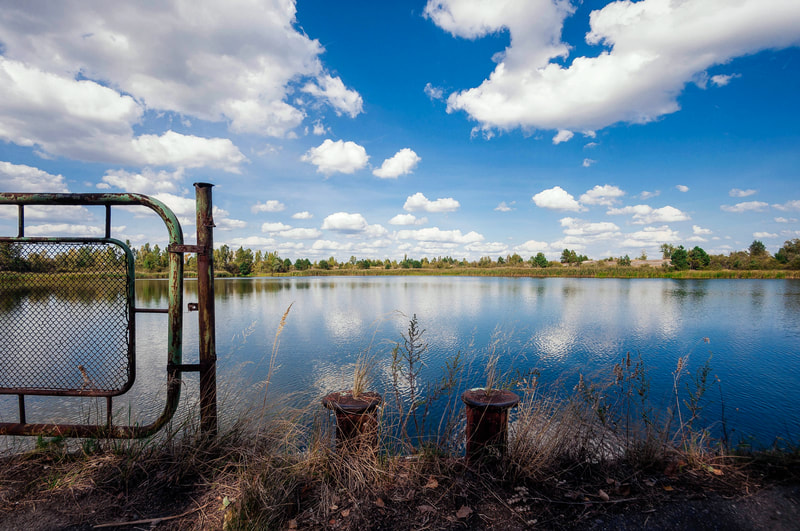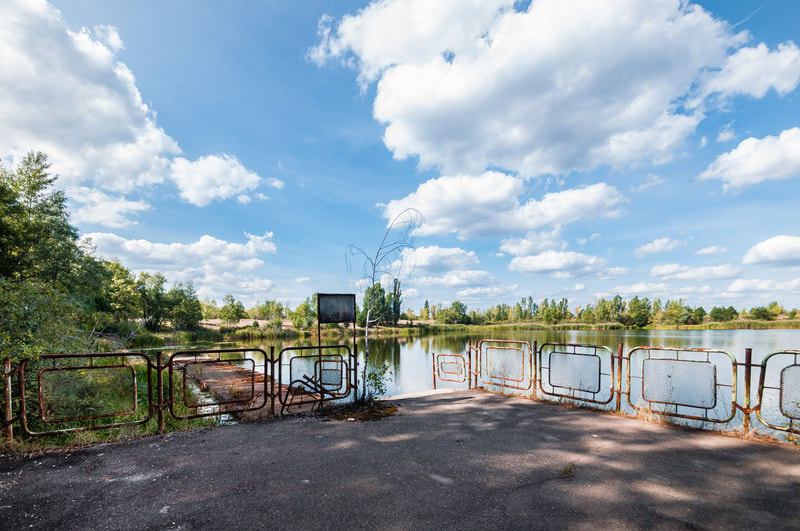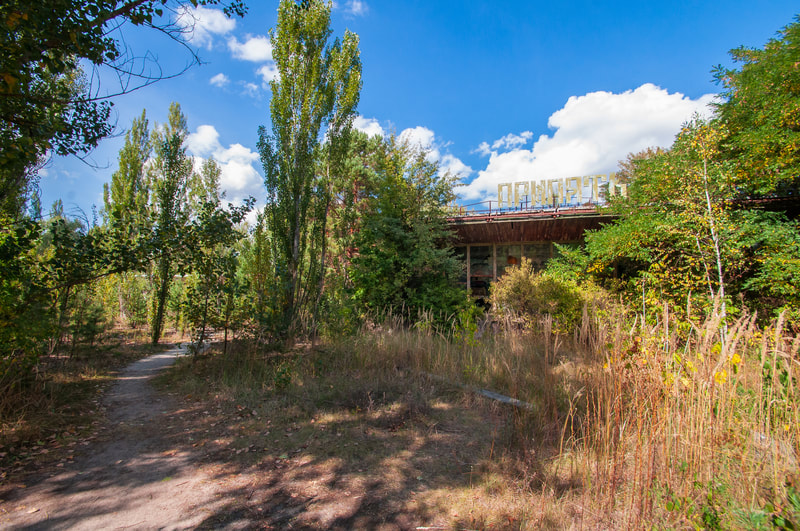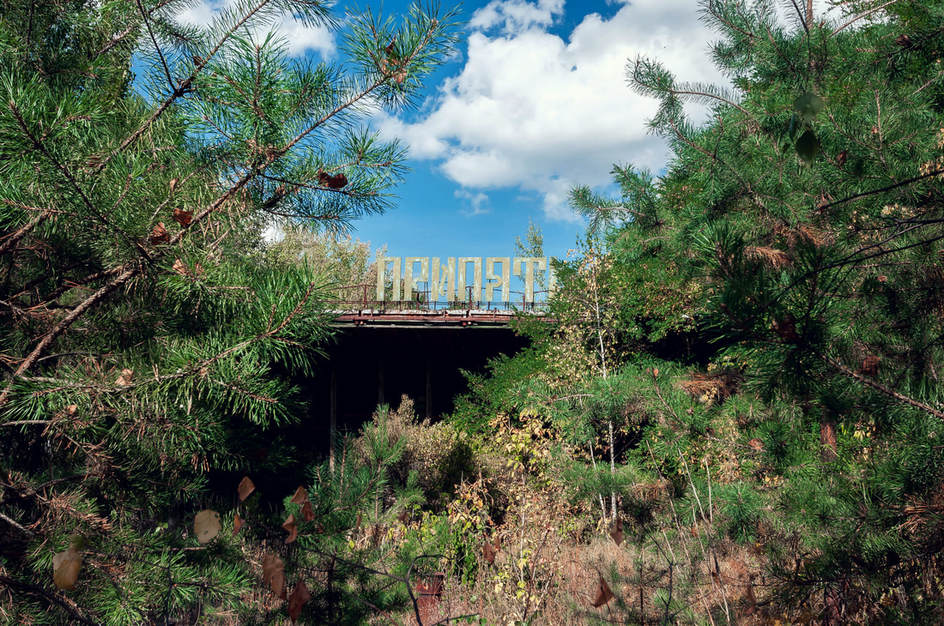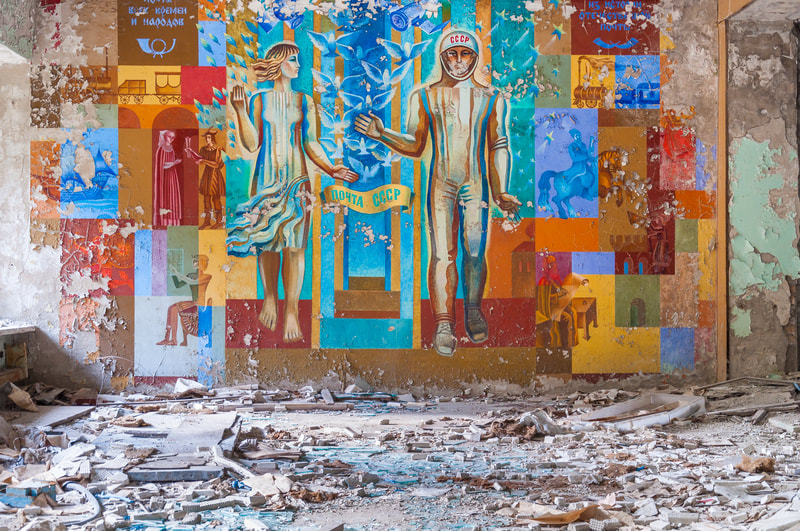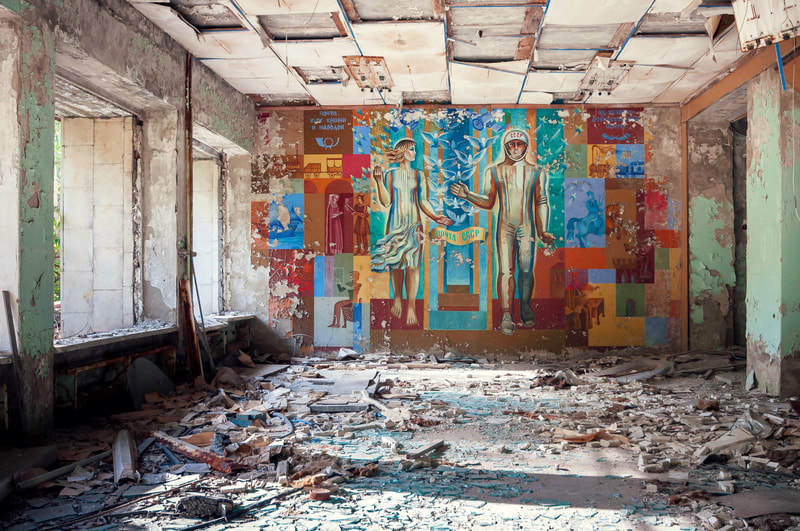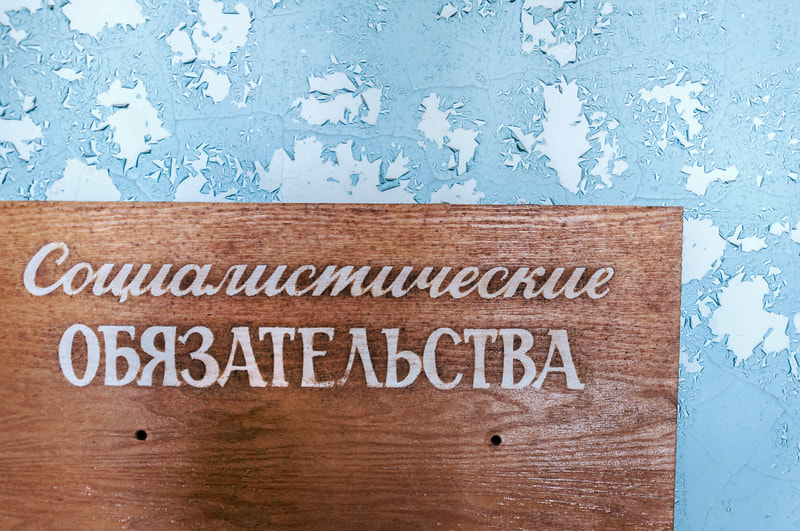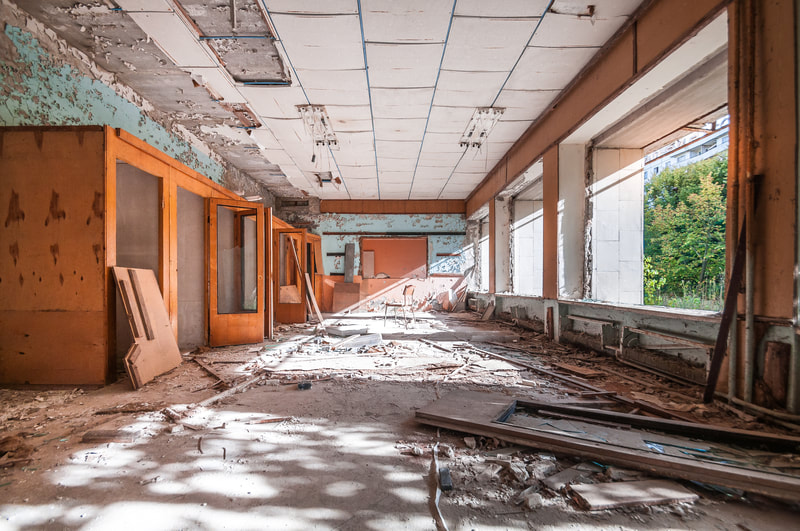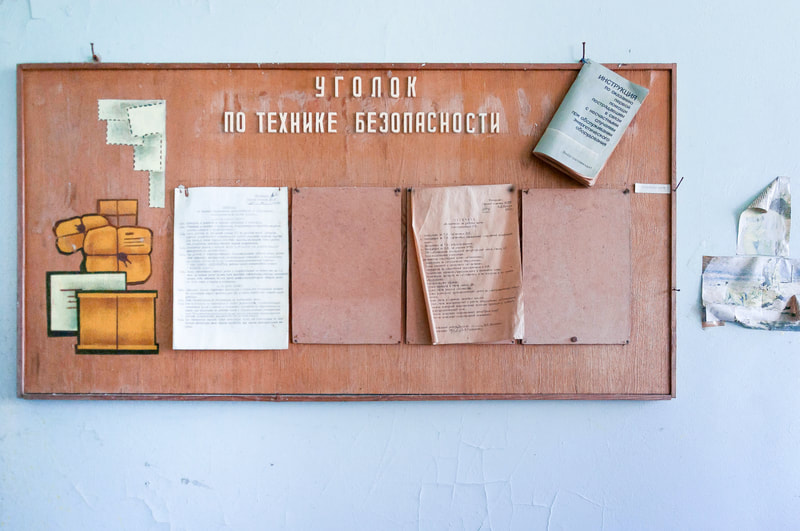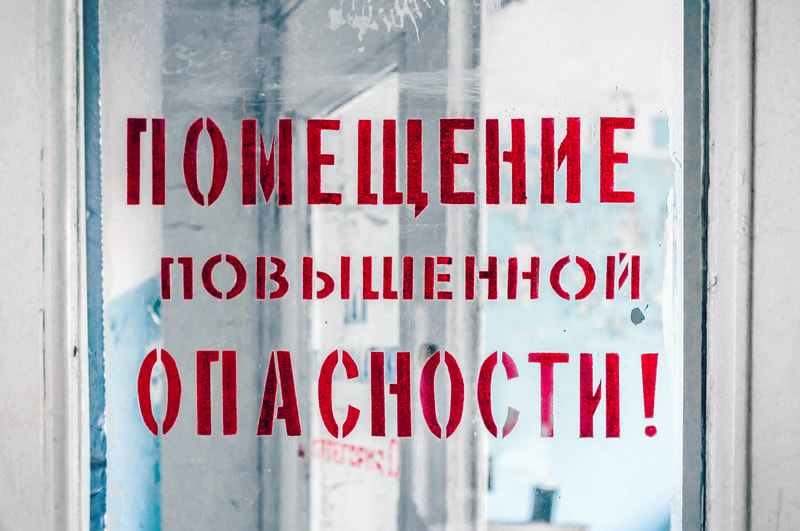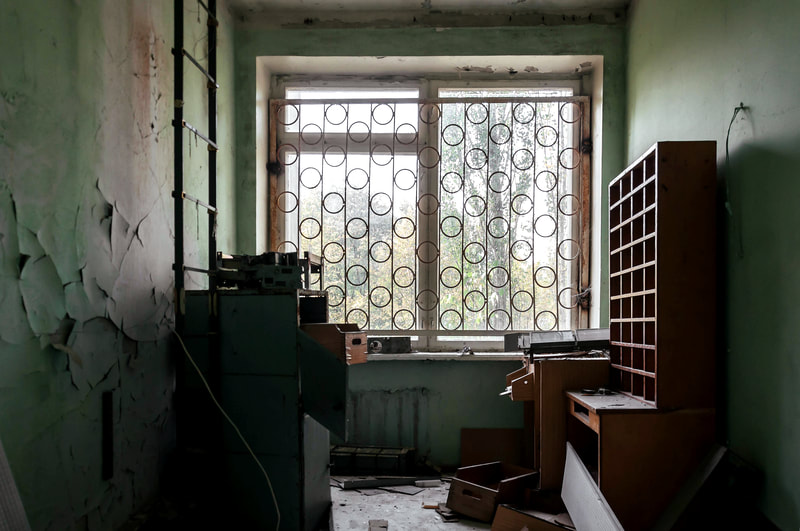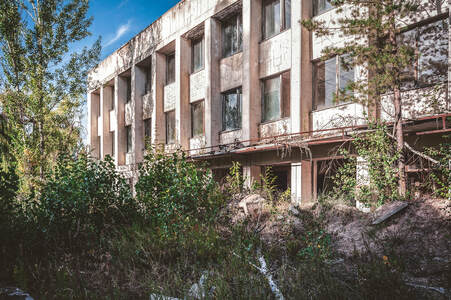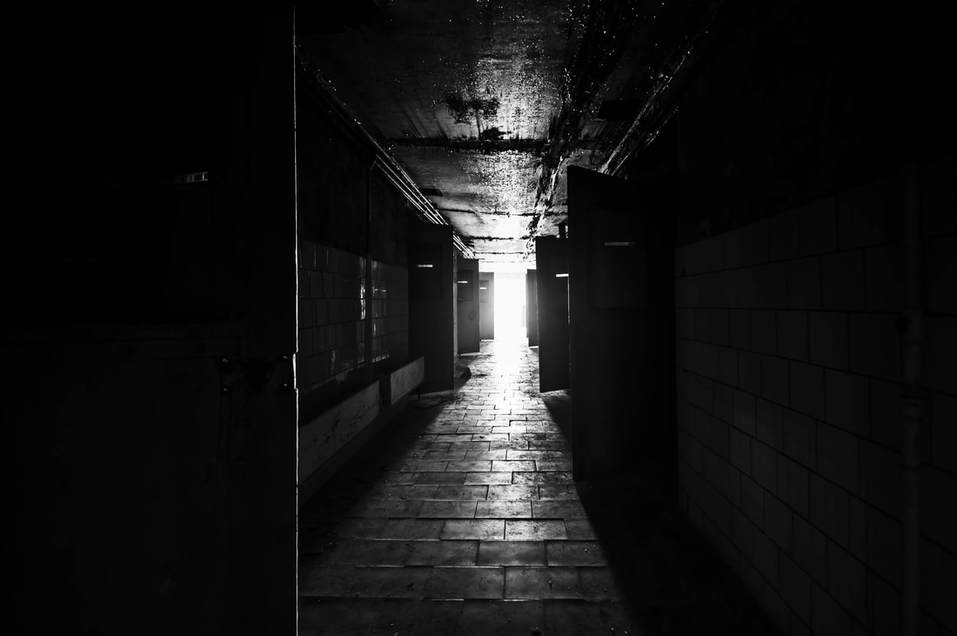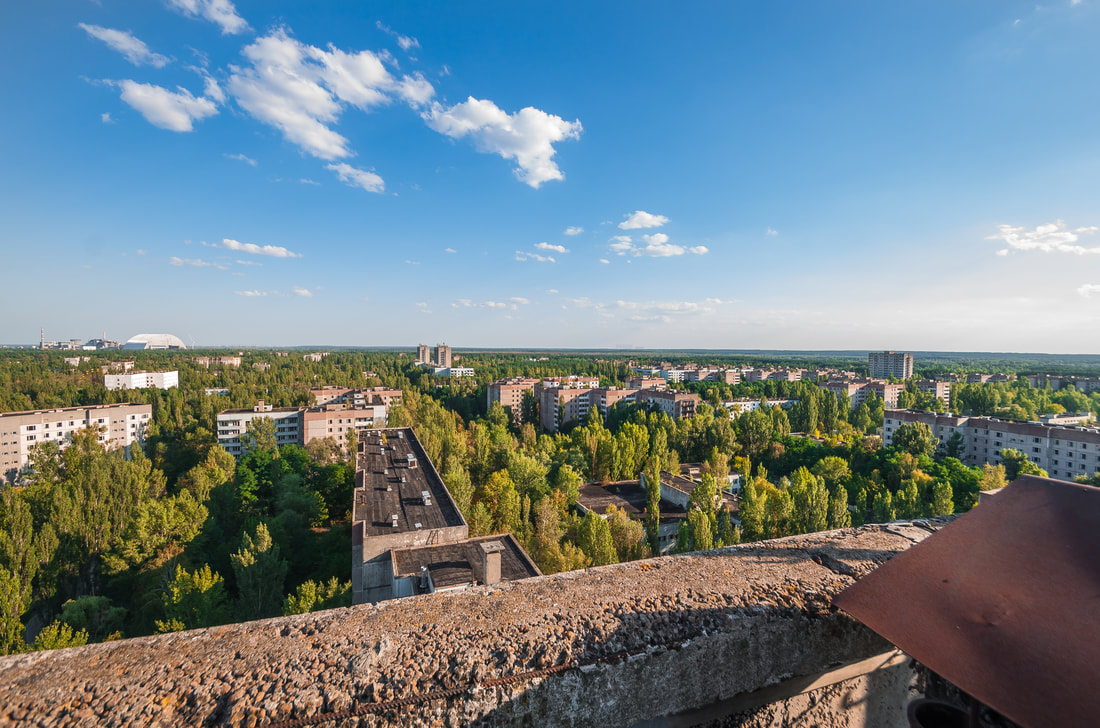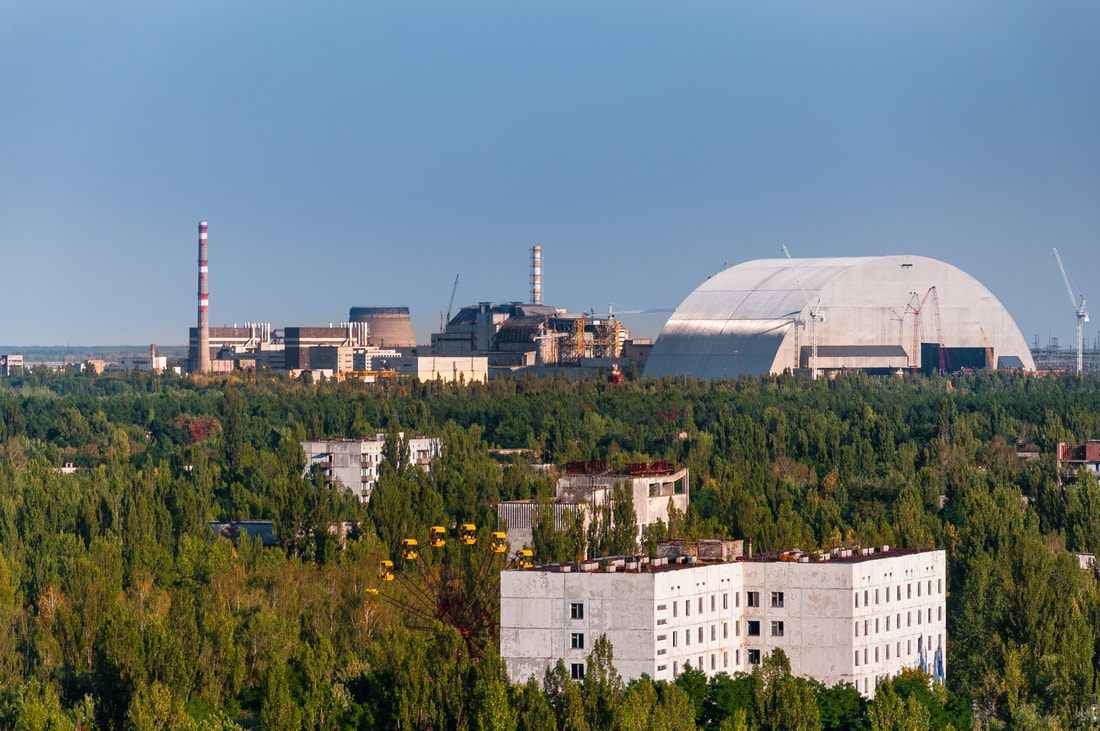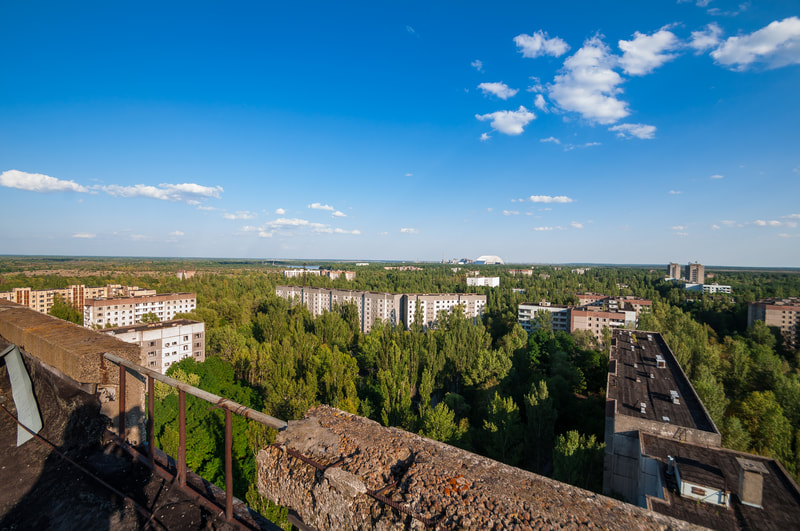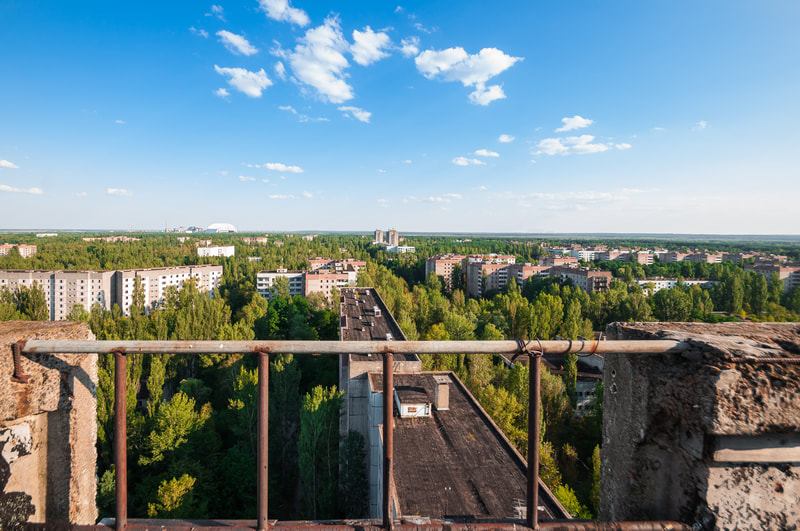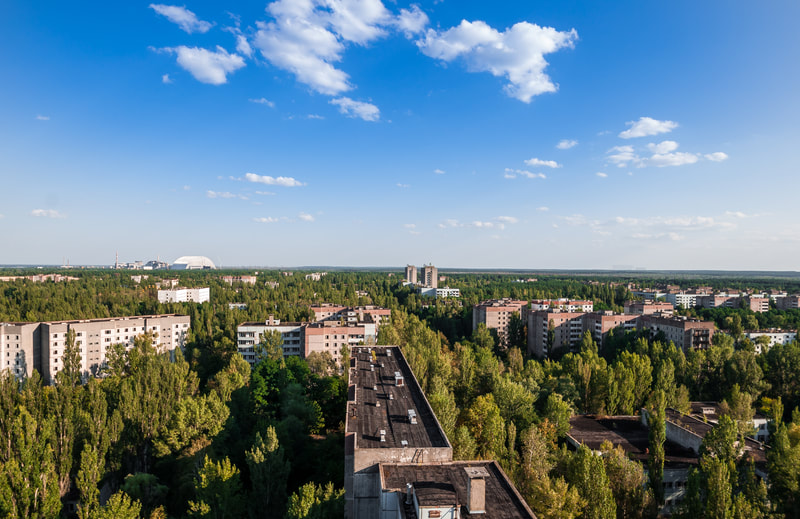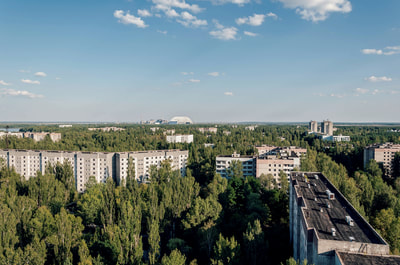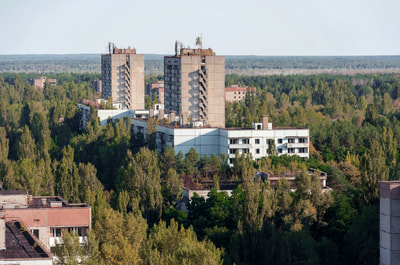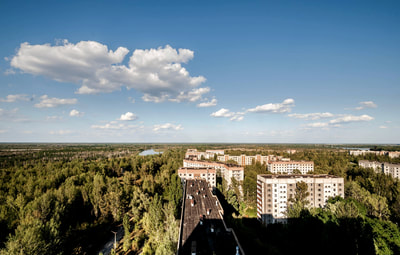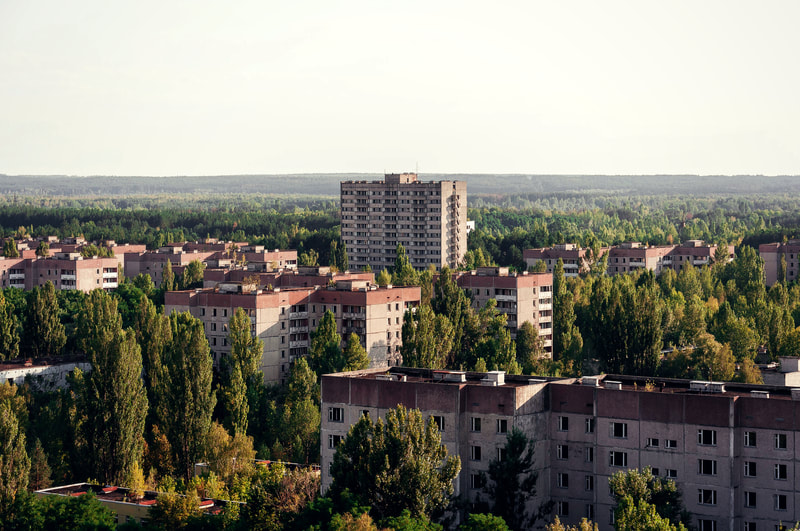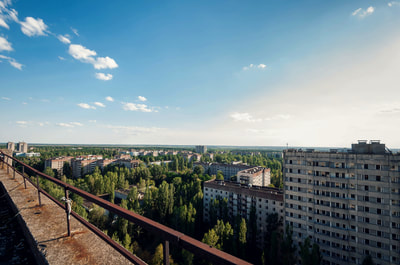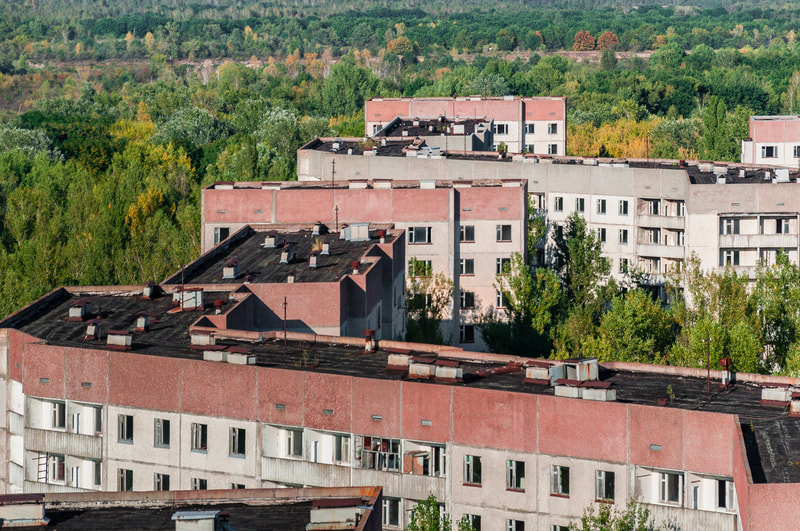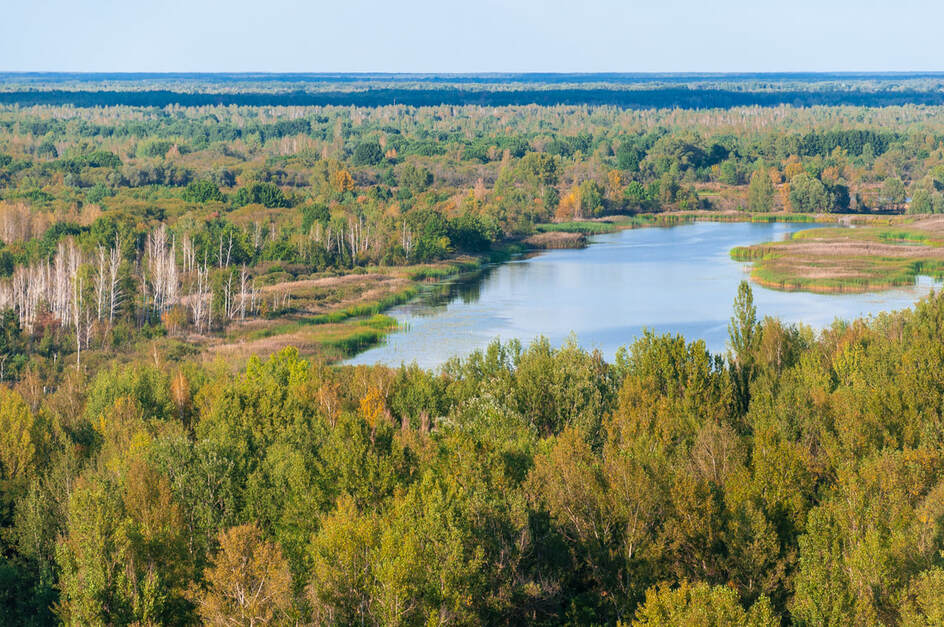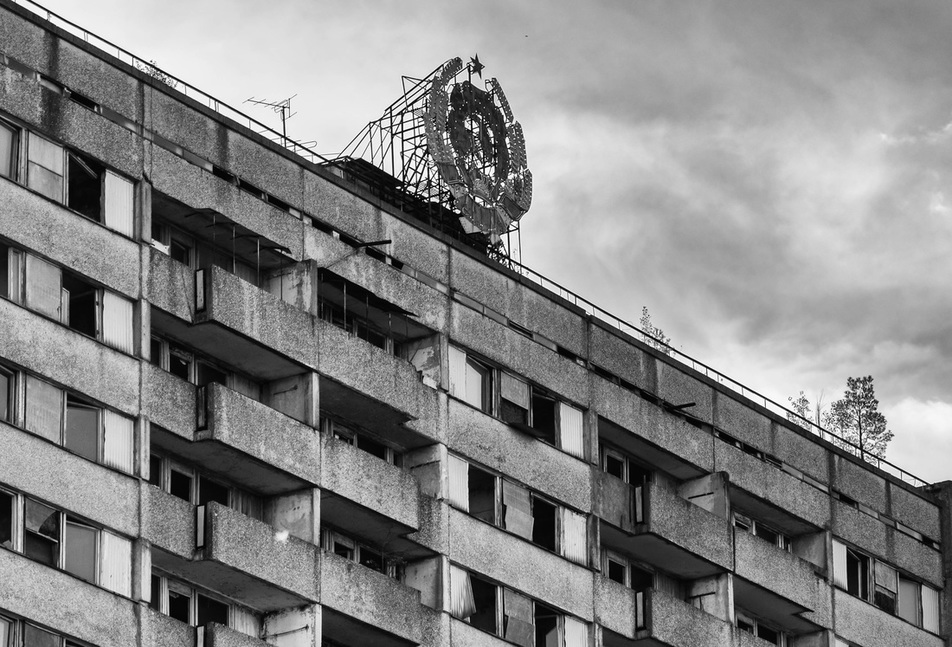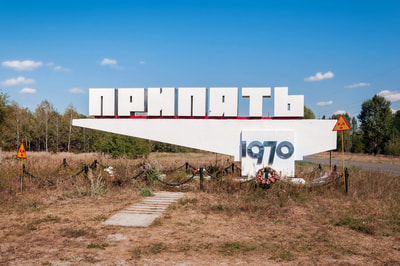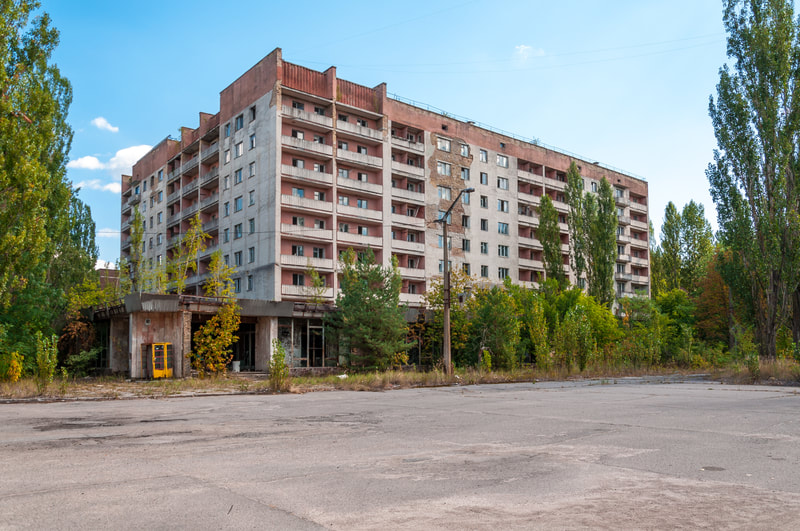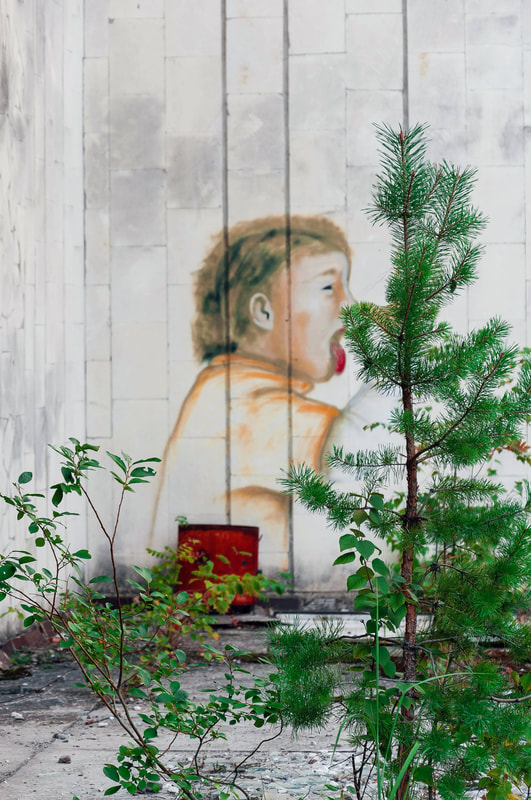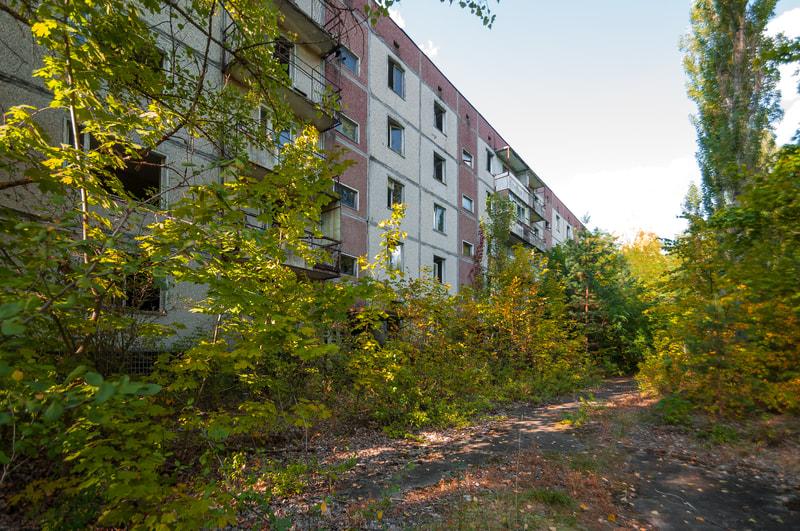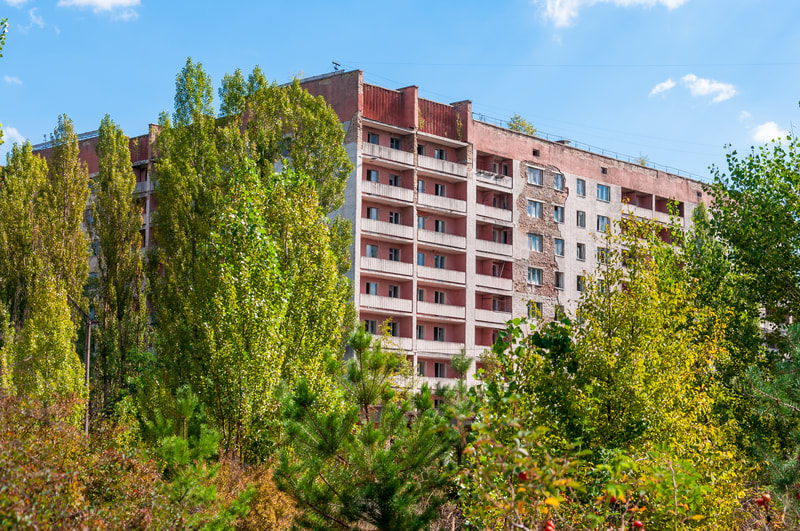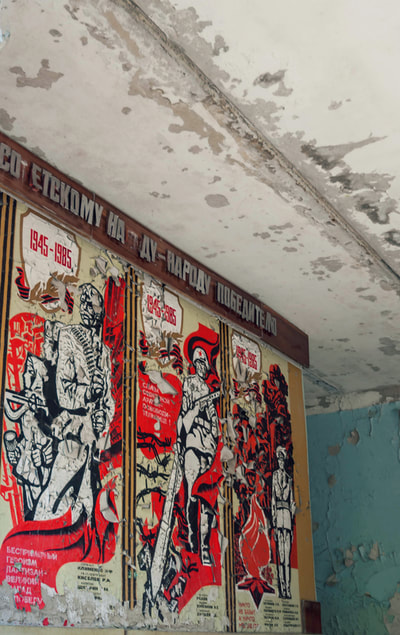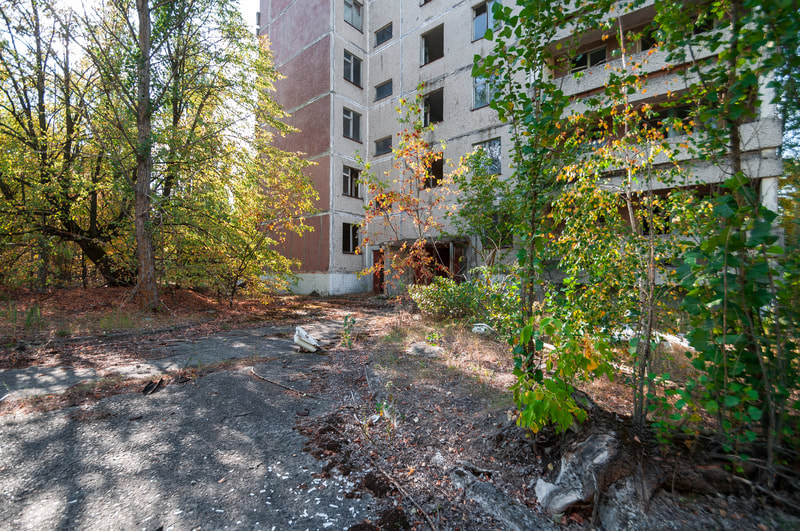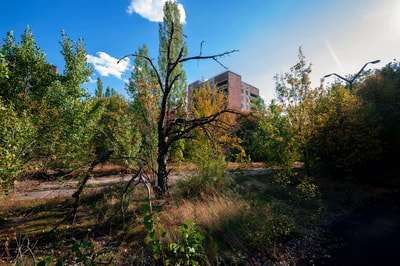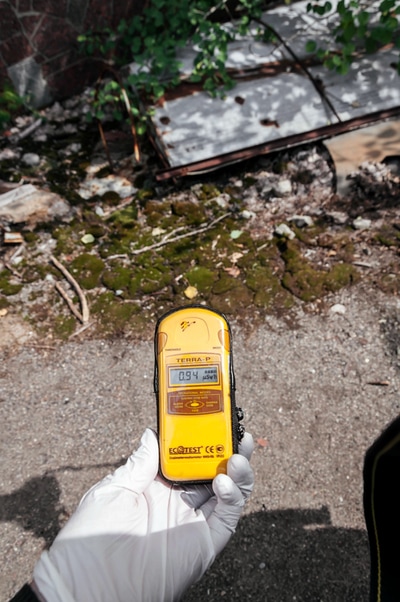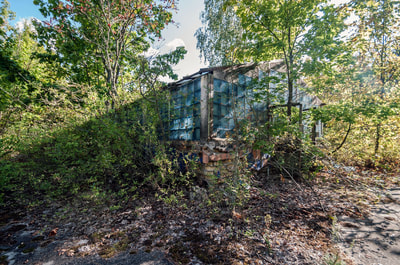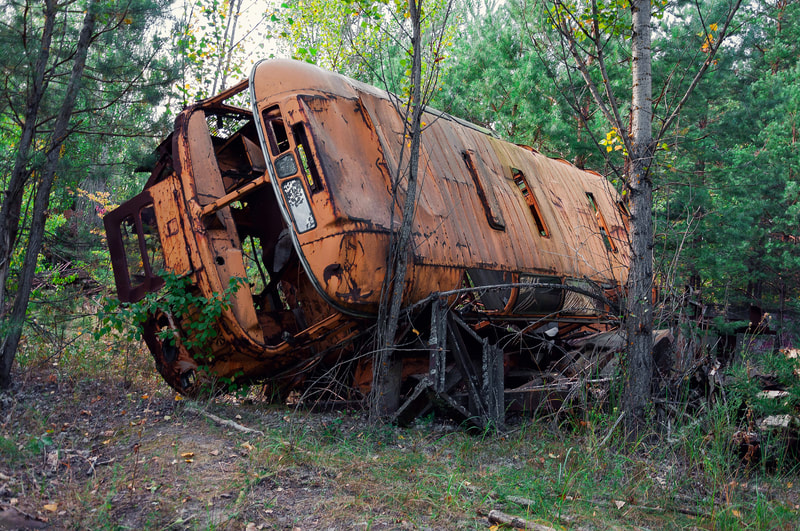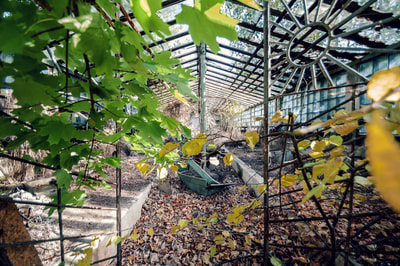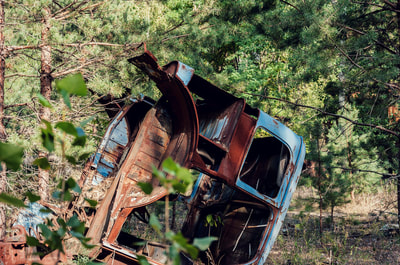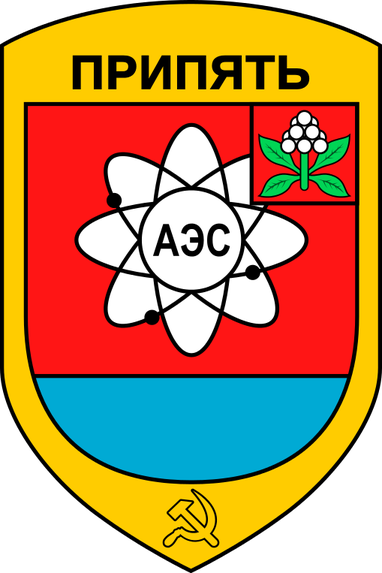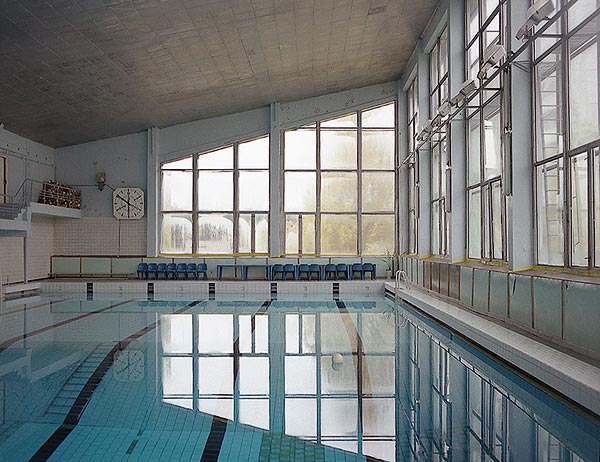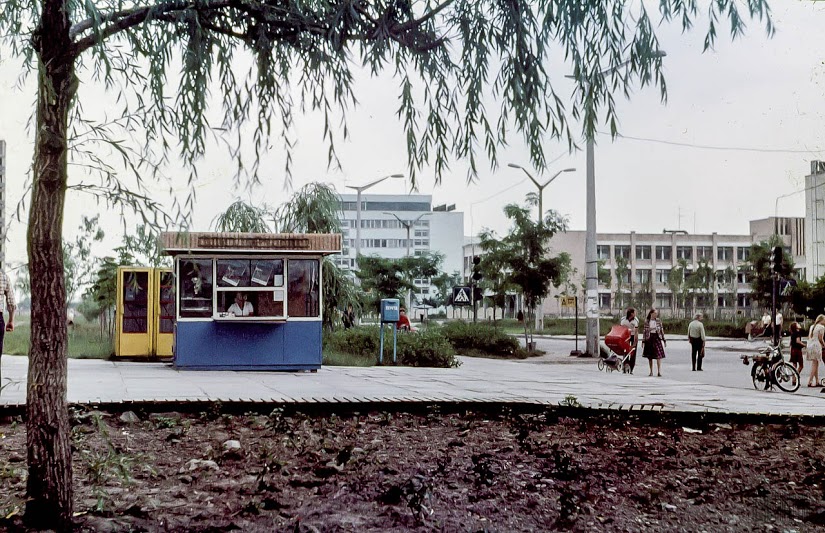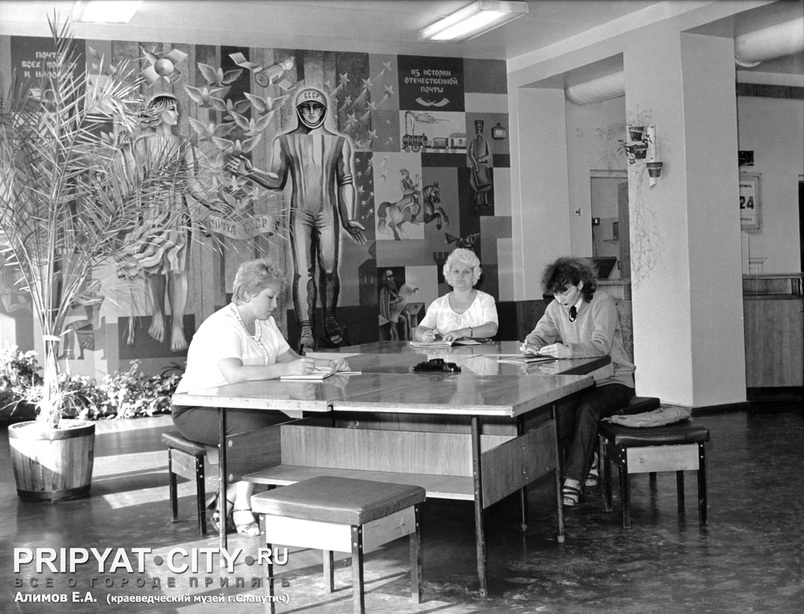Prypjat/Pripyat
(Прип'ять)
"[...] we lived in Pripyat, near the reactor. I can still see the bright-crimson glow, it was like the reactor was glowing.
This wasn´t an ordinary fire, it was some kind of emanation. It was pretty. [...] We didn't know, that death could be so beautiful."
(Nadezhda Vygovskaya (evacuee from Pripyat), excerpt from the book: Voices from Chernobyl by Svetlana Alexievich)
This wasn´t an ordinary fire, it was some kind of emanation. It was pretty. [...] We didn't know, that death could be so beautiful."
(Nadezhda Vygovskaya (evacuee from Pripyat), excerpt from the book: Voices from Chernobyl by Svetlana Alexievich)
Prypjat. Eine tote Stadt. Schön muss sie einst gewesen sein. Eine stolze und äußerst moderne Stadt. Letzteres besonders gemessen an dem Regime und der Zeit, in die die Geburtsstunde Prypjats fällt. Eine Zeit, in der die Welt in zwei Blöcke gespalten war. Gespalten in die Guten und die Bösen. Wer den einen oder den anderen zuzuordnen war, war davon abhängig, wo jenseits des so genannten Eisernen Vorhangs man sich befand, östlich oder westlich.
Mitten in dieser unruhigen Zeit, die von Säbelrasseln und Kräftemessen geprägt war, entstand nun die Stadt Prypjat in der heutigen Ukraine - damals natürlich noch zur Sowjetunion gehörig. Benannt nach dem nahe gelegenen Fluss, wurde sie im Jahr 1970 eingeweiht. Prypjat entstand auf dem Reißbrett und war eine sowjetische Planstadt. Die Arbeiter des nahe gelegenen Atomkraftwerks in Tschernobyl sowie ihre Familien sollten dort ihre neue Heimat finden und mangeln sollte es ihnen an nichts. Sechzehn Jahre lang war Pripyat auch die Stadt der Rosen. Überall wurden Rosenbüsche gepflanzt. Der Duft, den sie einst versprühten, muss atemberaubend gewesen sein.
Sechzehn Jahre lang lebten die Bewohner Prypjats friedlich neben einem vermeintlich gezähmten Moloch. Bis zu der Nacht am 26. April 1986, in der der Reaktor des Block 4 im AKW Tschernobyl explodierte. Nur etwa vier Kilometer liegen zwischen der Stadt der Rosen und dem havarierten Kraftwerk W. I. Lenin. Um 01:23 Uhr am 26. April '86 zerriss der Nachthimmel über Tschernobyl. Die durch die Explosion freigesetzte Strahlung war etwa 400-mal höher als die der US-Atombombenabwürfe auf die japanischen Städte Hiroshima und Nagasaki während des Zweiten Weltkrieges. Mit der Evakuierung der Bevölkerung hatte man es jedoch nicht sonderlich eilig. Erst im Verlauf des 27. April, 36 Stunden nach dem Unglück, wurden die knapp 50.000 Bewohner Prypjats mit über 1.000 Bussen nach und nach evakuiert und aus der Gefahrenzone gebracht. Das Durchschnittsalter der Einwohner lag bei etwa 26 Jahren. Noch ahnten die Menschen nichts von ihrer Reise ohne Wiederkehr. Nur das Nötigste wurde hastig gepackt - man rechnete schließlich fest damit, bald wieder nach Hause zurückzukehren. Nach drei Tagen sei der Spuk vorüber und die Bewohner könnten in ihre Wohnungen zurückkehren, so offizielle Behördenangaben. Doch zu dem Zeitpunkt wusste niemand, dass die Stadt für immer unbewohnbar bleiben würde. Niemand kehrte je wieder zurück. An jenem Tag starb die junge Stadt.
Heute, dreißig Jahre nach diesem Unglück, das die Welt wie noch nie zuvor veränderte und auch zum Fall der Sowjetunion beitrug, ist Prypjat der Inbegriff einer Geisterstadt sowie trauriges Beispiel für den vergeblichen Versuch des Menschen, die Natur zu beherrschen. Prypjat steht heute für die bisher verheerendste Atomkatastrophe der Welt. Es gibt keine offiziellen Statistiken über die Opferzahlen des Unglücks, lediglich Schätzungen. Fest steht jedoch, dass noch heute Menschen in Folge dieses Unglücks leiden und sterben. Heute ist die einst stolze Stadt der Rosen tot. Nichts als ein Friedhof voll grauer Betonskeletten, die sich nach und nach auflösen werden. Doch wer genau hinblickt, sieht das Leben zwischen den Ruinen blühen. Die Natur hat, lange nachdem der Mensch gegangen ist, ihren Weg gefunden. So finden sich heute zwischen den im Sommer teilweise kaum mehr sichtbaren Gebäuden und den Straßen, die mittlerweile zu engen Pfaden zusammengewachsen sind, hier und da wilde Rosenbüsche wuchern. Der Mensch ist gegangen. Doch die Rosen sind geblieben und versprühen noch immer den alten Duft.
Die evakuierten Menschen, fanden zum Teil einen neuen Wohnort in der aus dem Boden gestampften Stadt Slawutytsch (Славутич) - gerade einmal 40 km vom Unglücksreaktor entfernt. Diese wurde in Folge des Reaktorunglücks, im Jahr 1986 in Windeseile, wie einst Prypjat selbst, quasi auf dem Reißbrett errichtet. Slawutytsch stellt somit die jüngste Stadt der Ukraine dar.
Mitten in dieser unruhigen Zeit, die von Säbelrasseln und Kräftemessen geprägt war, entstand nun die Stadt Prypjat in der heutigen Ukraine - damals natürlich noch zur Sowjetunion gehörig. Benannt nach dem nahe gelegenen Fluss, wurde sie im Jahr 1970 eingeweiht. Prypjat entstand auf dem Reißbrett und war eine sowjetische Planstadt. Die Arbeiter des nahe gelegenen Atomkraftwerks in Tschernobyl sowie ihre Familien sollten dort ihre neue Heimat finden und mangeln sollte es ihnen an nichts. Sechzehn Jahre lang war Pripyat auch die Stadt der Rosen. Überall wurden Rosenbüsche gepflanzt. Der Duft, den sie einst versprühten, muss atemberaubend gewesen sein.
Sechzehn Jahre lang lebten die Bewohner Prypjats friedlich neben einem vermeintlich gezähmten Moloch. Bis zu der Nacht am 26. April 1986, in der der Reaktor des Block 4 im AKW Tschernobyl explodierte. Nur etwa vier Kilometer liegen zwischen der Stadt der Rosen und dem havarierten Kraftwerk W. I. Lenin. Um 01:23 Uhr am 26. April '86 zerriss der Nachthimmel über Tschernobyl. Die durch die Explosion freigesetzte Strahlung war etwa 400-mal höher als die der US-Atombombenabwürfe auf die japanischen Städte Hiroshima und Nagasaki während des Zweiten Weltkrieges. Mit der Evakuierung der Bevölkerung hatte man es jedoch nicht sonderlich eilig. Erst im Verlauf des 27. April, 36 Stunden nach dem Unglück, wurden die knapp 50.000 Bewohner Prypjats mit über 1.000 Bussen nach und nach evakuiert und aus der Gefahrenzone gebracht. Das Durchschnittsalter der Einwohner lag bei etwa 26 Jahren. Noch ahnten die Menschen nichts von ihrer Reise ohne Wiederkehr. Nur das Nötigste wurde hastig gepackt - man rechnete schließlich fest damit, bald wieder nach Hause zurückzukehren. Nach drei Tagen sei der Spuk vorüber und die Bewohner könnten in ihre Wohnungen zurückkehren, so offizielle Behördenangaben. Doch zu dem Zeitpunkt wusste niemand, dass die Stadt für immer unbewohnbar bleiben würde. Niemand kehrte je wieder zurück. An jenem Tag starb die junge Stadt.
Heute, dreißig Jahre nach diesem Unglück, das die Welt wie noch nie zuvor veränderte und auch zum Fall der Sowjetunion beitrug, ist Prypjat der Inbegriff einer Geisterstadt sowie trauriges Beispiel für den vergeblichen Versuch des Menschen, die Natur zu beherrschen. Prypjat steht heute für die bisher verheerendste Atomkatastrophe der Welt. Es gibt keine offiziellen Statistiken über die Opferzahlen des Unglücks, lediglich Schätzungen. Fest steht jedoch, dass noch heute Menschen in Folge dieses Unglücks leiden und sterben. Heute ist die einst stolze Stadt der Rosen tot. Nichts als ein Friedhof voll grauer Betonskeletten, die sich nach und nach auflösen werden. Doch wer genau hinblickt, sieht das Leben zwischen den Ruinen blühen. Die Natur hat, lange nachdem der Mensch gegangen ist, ihren Weg gefunden. So finden sich heute zwischen den im Sommer teilweise kaum mehr sichtbaren Gebäuden und den Straßen, die mittlerweile zu engen Pfaden zusammengewachsen sind, hier und da wilde Rosenbüsche wuchern. Der Mensch ist gegangen. Doch die Rosen sind geblieben und versprühen noch immer den alten Duft.
Die evakuierten Menschen, fanden zum Teil einen neuen Wohnort in der aus dem Boden gestampften Stadt Slawutytsch (Славутич) - gerade einmal 40 km vom Unglücksreaktor entfernt. Diese wurde in Folge des Reaktorunglücks, im Jahr 1986 in Windeseile, wie einst Prypjat selbst, quasi auf dem Reißbrett errichtet. Slawutytsch stellt somit die jüngste Stadt der Ukraine dar.
Pripyat. It must has been a beautiful city once. A proud and modern city. The latter is special compared to the regime and time Pripyat was born. It was a time, when the world was divided into two blocks. The good and the bad one. To which side you belonged was decided on which side you lived. East or west of the iron curtain.
The city was built right in the midst of those times which were characterized by sabre-rattling among those two hostile blocks. Today, the ghost town of Pripyat is located in the Ukraine, which belonged to the Soviet Union in the past. Pripyat was named after the identically named river and was inaugurated in the year 1970. The city went from the drawing board to reality in only short time. It mainly housed workers of the nearby Chernobyl power plant, which was named after the founder of the Soviet Union, Lenin. For 16 years, Pripyat had been known as the city of roses. Rose bushes were planted all over the city. The scent must had been indescribable breathtaking.
For 16 years, the 50,000 citizen of Pripyat had lived peacefully near an apparently tamed juggernaut. Until the night of the 26th of April 1986, when reactor 4 of the Chernobyl nuclear power plant exploded and destroyed the silence of the night. Only four kilometers lie between the city of roses and the wrecked power station. Yet, it wasn't before the 27th of April, 36 hours after the disaster took place, that the inhabitants of Pripyat were gradually evacuated by around 1,000 buses. The average age of the residents was 26 years at that time. It was the day, the young city died. None of the citizen knew about their journey with no return. They were officially told that they would return three days after the evacuation. It was only one of many lies the inhabitants had to endure as well as the world itself. As a consequence of that lie many people only packed the most necessary things. No one knew that the Pripyat would stay uninhabitable for good.
Today, Pripyat is the mother-of-all of a ghost town and a disaster that changed the world like never before. The disaster was also one of the reasons that caused the fall of the Soviet Union. Pripyat is also the epitome of a vain attempt to rule mother nature. Until today there are no official statistics concerning the number of casualties. It's a fact that many people still suffer and die as consequence of this catastrophe. Today, the city of roses is a dead town. Yet, nature has found its way back after man has gone. Today, the main roads are now small paths and the rose bushes which have transformed into wild roses are still growing all over the now empty city.
In the same year of the disaster, 1986, many of the evacuees found a new home in the city Slavutych (Славутич)which was hammered out in the dead of night and is located only 40 kilometers away from the damaged reactor - on the brink of the Chernobyl exclusion zone. Slavutych is the youngest city in Ukraine.
The city was built right in the midst of those times which were characterized by sabre-rattling among those two hostile blocks. Today, the ghost town of Pripyat is located in the Ukraine, which belonged to the Soviet Union in the past. Pripyat was named after the identically named river and was inaugurated in the year 1970. The city went from the drawing board to reality in only short time. It mainly housed workers of the nearby Chernobyl power plant, which was named after the founder of the Soviet Union, Lenin. For 16 years, Pripyat had been known as the city of roses. Rose bushes were planted all over the city. The scent must had been indescribable breathtaking.
For 16 years, the 50,000 citizen of Pripyat had lived peacefully near an apparently tamed juggernaut. Until the night of the 26th of April 1986, when reactor 4 of the Chernobyl nuclear power plant exploded and destroyed the silence of the night. Only four kilometers lie between the city of roses and the wrecked power station. Yet, it wasn't before the 27th of April, 36 hours after the disaster took place, that the inhabitants of Pripyat were gradually evacuated by around 1,000 buses. The average age of the residents was 26 years at that time. It was the day, the young city died. None of the citizen knew about their journey with no return. They were officially told that they would return three days after the evacuation. It was only one of many lies the inhabitants had to endure as well as the world itself. As a consequence of that lie many people only packed the most necessary things. No one knew that the Pripyat would stay uninhabitable for good.
Today, Pripyat is the mother-of-all of a ghost town and a disaster that changed the world like never before. The disaster was also one of the reasons that caused the fall of the Soviet Union. Pripyat is also the epitome of a vain attempt to rule mother nature. Until today there are no official statistics concerning the number of casualties. It's a fact that many people still suffer and die as consequence of this catastrophe. Today, the city of roses is a dead town. Yet, nature has found its way back after man has gone. Today, the main roads are now small paths and the rose bushes which have transformed into wild roses are still growing all over the now empty city.
In the same year of the disaster, 1986, many of the evacuees found a new home in the city Slavutych (Славутич)which was hammered out in the dead of night and is located only 40 kilometers away from the damaged reactor - on the brink of the Chernobyl exclusion zone. Slavutych is the youngest city in Ukraine.
Prypjat von oben - Aerial view of Pripyat
(© google earth, 2017)
Rummelplatz - Amusement park
Der Freizeitpark in Prypjat steht wohl wie sonst nichts als Symbol für die Nuklearkatastrophe von Tschernobyl. Die Radioaktivität im und um den Park ist, verglichen mit anderen Orten in der Stadt, relativ hoch. Nach dem Unglück wurde der Park als Landefläche für die Helikopter, die nuklear verseuchtes Material transportierten genutzt. Bei Aufräumarbeiten durch die Liquidatoren gelangte ein Großteil dieses Materials in das Erdreich. Besonders moosige Flächen sind stark kontaminiert.
The amusement park has become the symbol of the Chernobyl nuclear disaster. Radiation levels in the park area are pretty high, compared to other places in Pripyat. The park was used as landing strip for helicopters that transported radioactive materials. During cleaning work carried out by the liquidators a lot of the material got into the soil. Especially parts that are still covered with moss are still highly contaminated.
Kulturpalast Energetik - Cultural Palace Energetik
Der Kulturpalast Energetik inklusive Theater, Sporthalle und Disko war einst das kulturelle Zentrum der sowjetischen Musterstadt. In einem Raum nahe dem alten Theatersaal findet man noch alte Konterfeis von einstigen Sowjetpolitikern, die für die kurz bevorstehende Mai-Parade '86 zum Einsatz hätten kommen sollen.
The palace of culture Energetik with its theater, gym and disco was once the cultural heart of Pripyat. In a room next to the theater are stil some old pictures of former Soviet politicians. The images were planned to be part of the upcoming May day parade of '86, which - of course - never took place.
Mittelschule Nr. 3 - Middle School No. 3
Schwimmbad Lazurny - Swimming pool Lazurny
Das Schwimmbad Prypjats namens Lazurny (zu deutsch: "Azur") wurde nach der Katastrophe, wenn auch schwer vorstellbar, noch bis in das Jahr 1996 von den Liquidatoren genutzt.
The old swimming pool of Pripyat named Lazurny (engl. "azure"), was still in use after the catastrophe - even if it´s hard to imagine. Thus, liquidators still used it until the year 1996, when it was finally abandoned.
Krankenhaus Nr. 126 und Pathologie - Hospital No. 126 and morgue
Das Krankenhaus Nr. 126 Prypjats verfügte über 410 Betten und stellte das größte - neben drei weiteren Kliniken - medizinische Versorgungszentrum der Stadt dar. Noch heute zählt das Kellergeschoss der Klinik zu einem der am stärksten kontaminierten Orte der Sperrzone - und überdies ist es einer der radioaktivsten der Welt. Noch immer liegen dort im Dunkel die Anzüge der ersten sechs Feuerwehrmänner, die direkt am havarierten Reaktor arbeiteten und direkt nach ihrem Einsatz in eben dieses Krankenhaus gebracht wurden. Sie verstarben bald darauf an der Strahlenkrankheit. Noch immer, 30 Jahre nach dem Unglück, strahlen die Anzüge so stark, dass man ohne Schutz binnen kürzester Zeit einer tödlichen Dosis ausgesetzt wäre.
The hospital no. 126 consisted of 410 beds and was - among three further clinics - the biggest medical center of Pripyat. Until today the basement of the hospital is not only one of the most contaminated places of the Chernobyl exclusion zone, but of the world. Still, the pitch-dark cellar, holds the suits of the six firemen that were the first to work on the wrecked reactor and afterwards were instantly brought to the city hospital. Of course they received a lethal dose of radiation. Consequently, they died shortly after their service of radiation sickness. Still, 30 years after the catastrophe has happend, the suits are so highly cotaminated that you would receive a lethal dose within only short time.
Avanhard-Stadion - Avanhard-Stadium
Das Stadion Pripyats, einst Heimspielstätte des stadteigenen FC Stroitel Prypjat. Benannt wurde es nach der ehemaligen ukrainischen Sportorganisation Avanhard (ukr. Авангард). Eröffnet wurde dieses im Jahre 1974.
The stadium of Pripyat was once home ground of the FC Stroitel Pripyat. The stadium was named after the former Ukrainian sports organisation Avanhard (Авангард). It was opened in 1974.
Kino Prometheus sowie Musikschule - Cinema Prometheus and Music School
Supermarkt und Klaviergeschäft - Supermarket and piano shop
Café Prypjat am gleichnamigen Fluss - Café Pripyat at the same-named river
Das Café Prypjat war eine der vielen Freizeiteinrichtungen der Stadt. Man bedenke immer die Zeit, in der man sich damals befand. Gar prunkvoll erscheinen somit die Buntglasfenster im Café, das direkt neben dem Fluss Prypjat gelegen war. Selbst einen eigenen Bootsanleger für die Gäste gab es dort.
The café Pripyat was one of numerous leisure institutions within the city. Considering the general living conditions of the Soviet Union it's more than clear that the café with its ostentatious looking stained-glass windows right next to the riiver Pripyat was something special. There even was an own jetty for the guests of the café.
Postamt und Bank - Post office and bank
Polizeistation mit Gefängnis - Police station with jail
Kurzes Video aus dem Zellentrakt - Short video I took at the cell block:
Prypjat von oben - Pripyat from above
"It is so quiet out here, it is the quietest place on earth."
(Quote from the film "Stalker", 1979)
(Quote from the film "Stalker", 1979)
Von oben lässt sich am besten ein Eindruck über die einstige Größe der Stadt gewinnen. In diesem Fall entstanden die folgenden Aufnahmen vom Dach eines 16-stöckigen Gebäudes. Für mich zählt die Erfahrung, dort oben gewesen zu sein, zu einem der beeindruckendsten Momente meines Lebens. Kurze Zeit, nachdem ich mich nach dem doch sportlichen Aufstieg gesammelt hatte, erschlug mich eine Tatsache förmlich: die unbeschreibliche Stille. Kein Autolärm, keine Flugzeuge, keine Menschen. Selbst Vögel sind dort oben nicht zu hören. Für unsere heute doch meist dicht besiedelten Gebiete - Ausnahmen bestätigen die Regel - kaum vorstellbar. Selbst bei einem Waldspaziergang hört man noch immer, wenn auch stark gedämpft, die typischen Zivilisationsgeräusche. Plötzlich war dieses altbekannte Hintergrundrauschen nicht mehr vorhanden und mir wurde klar, dass ich noch nie solch eine Stille vernommen hatte. Totenstille schießt es mir als erstes durch den Kopf. Dieser Eindruck hallt auch bis heute noch nach. Besonders die Tatsache, auf eindeutige Zeichen, einstigen menschlichen Lebens zu blicken, macht die Erfahrung umso irrealer. Eine ganze Stadt liegt mir zu Füßen und ich höre - nichts. Ich werfe einen letzten Blick auf den havarierten Reaktor 4, der in der Ferne emporragt und bald unter der neuen Schutzhülle ("New Safe Confinement") verschwunden sein wird. So friedlich das alles wirken mag, das Gefühl ein später Zeuge eines kaum fassbaren Unglücks geworden zu sein, beschäftigt mich doch noch lange.
There is no better way to get a glimpse of the former size of the city than standing on a 16-storey-building, where the following captures were taken. For me, standing up there, was by far one of the most impressive experiences of my whole life. Only short time after the hard climb up the stairs, one thing really hit me in an instant: an indescribable silence I have never witnessed before. No cars, no air planes, no humans. Even birds are hardly singing. It´s probably hard to imagine for lots of people, at least for those living in densely populated areas. Even during a walk in the woods, one normally can hear the typical background noise of civilization. Suddenly, that noise was gone. My first thought was: dead silence. That impression is still affecting me deeply. The fact to look down on former traces of human lives only add to the unreal atmosphere. A whole city is at my feet and all I can hear is simply - nothing. I take a last look at the wrecked reactor no. 4 in the distance that soon will be disappeared underneath the new so-called New Safe Confinement (NSC). Despite the peaceful atmosphere, I still have the uneasy feeling of being a belated witness of a catastrophe which is hard to comprehend.
Vermischtes - Miscellaneous
Prypjat damals - Pripyat back in time
Wappen der Stadt Prypjat - Coat of arms of the city of Pripyat
(©public domain of Ukraine (https://en.wikipedia.org/wiki/Pripyat#/media/File:Coat_of_Arms_of_Pripyat.svg))
Die alte Schwimmhalle im Jahr 1996 - The old swimming pool in 1996
Das Schwimmbad Prypjats wurde, wenn auch schwer vorstellbar, bis ins Jahr 1996 von Liquidatoren in Betrieb gehalten.
- The old swimming pool of Pripyat was - although it´s hard to imagine - used by liquidators until the year 1996.
(Припять, Октябрь 1996. Бассейн «Лазурный» ещё функционирует, English: Pripyat October 1996-Swimming Pool, © Darek83, CC BY-SA 3.0)
Straßenszene Prypjats, 1983 - On the streets of Pripyat, 1983
(CC BY-SA 3.0 - ©Reaper 2122, 23. April 1983)
Postamt Pripyat - Post office of Prypjat
(pripyat.city.ru)



